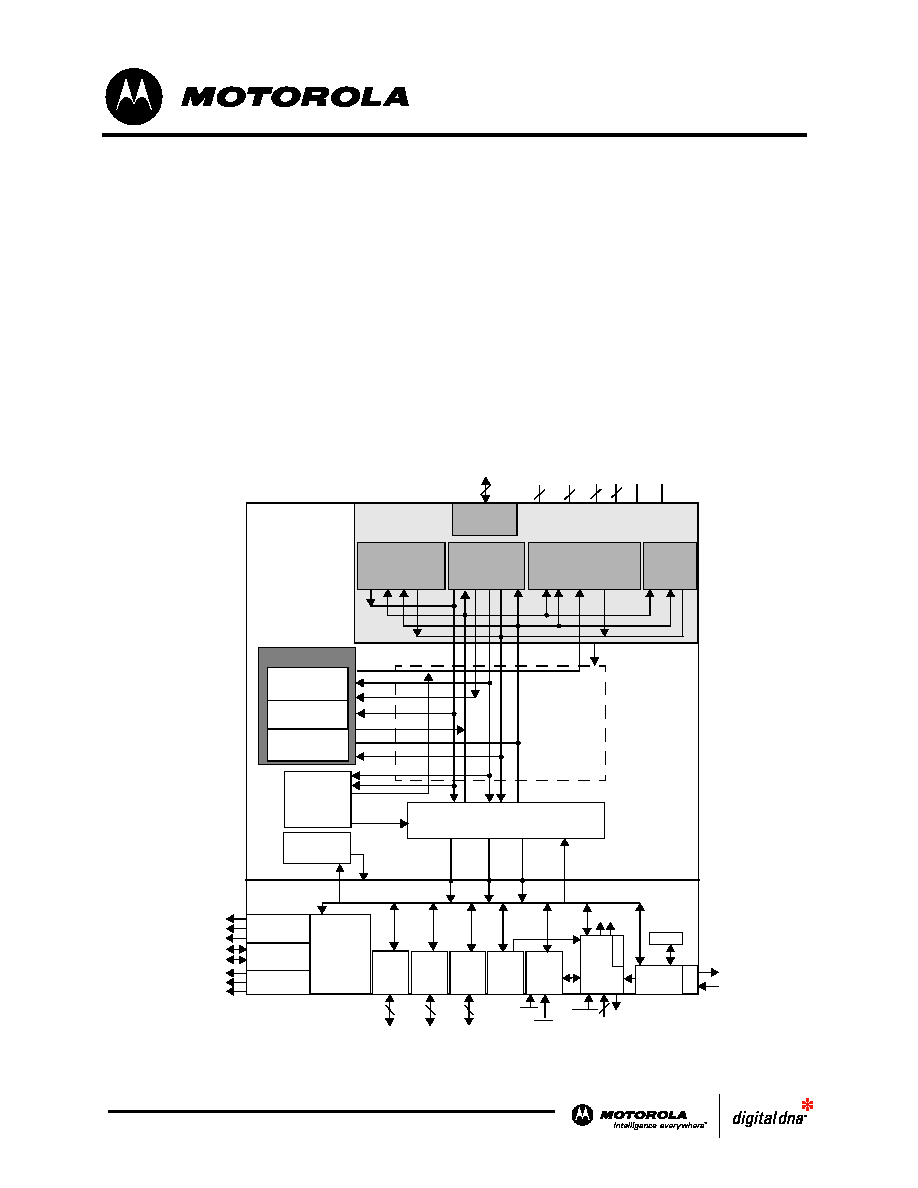
DSP56852/D
Rev. 3.0 3/2003
© Motorola, Inc., 2003. All rights reserved.
DSP56852
Preliminary Technical Data
DSP56852 16-bit Digital Signal Processor
∑ 120 MIPS at 120MHz
∑ 6K x 16-bit Program SRAM
∑ 4K x 16-bit Data SRAM
∑ 1K x 16-bit Boot ROM
∑ 21 External Memory Address lines, 16 data lines
and four chip selects
∑ One (1) Serial Port Interface (SPI) or one (1)
Improved Synchronous Serial Interface (ISSI)
∑ One (1) Serial Communication Interface (SCI)
∑ Interrupt Controller
∑ General Purpose 16-bit Quad Timer
∑ JTAG/Enhanced On-Chip Emulation (OnCETM) for
unobtrusive, real-time debugging
∑ Computer Operating Properly (COP)/Watchdog
Timer
∑ 81-pin MAPBGA package
∑ Up to 11 GPIO
Figure 1. DSP56852 Block Diagram
JTAG/
Enhanced
OnCE
Program Controller
and
Hardware Looping Unit
Data ALU
16 x 16 + 36
36-Bit MAC
Three 16-bit Input Registers
Four 36-bit Accumulators
Address
Generation Unit
Bit
Manipulation
Unit
PLL
Clock
Generator
16-Bit
DSP56800E Core
XTAL
EXTAL
Interrupt
Controller
COP/
Watch-
dog
1 Quad
Timer
or A17,
A18
2
CLKO
muxed (A20)
External Address
Bus Switch
External Bus
Interface Unit
6
RESET
IRQA
IRQB
V
DD
V
SSIO
V
DDA
V
SSA
External Data
Bus Switch
Bus Control
WR Enable
RD Enable
CS[2:0] muxed (GPIOA)
A0-16
MODE
D0-D12[12:0]
6
Program Memory
6144 x 16 SRAM
Boot ROM
1024 x 16 ROM
Data Memory
4096 x 16 SRAM
PDB
PDB
XAB1
XAB2
XDB2
CDBR
SSI or
SPI or
GPIOC
SCI or
GPIOE
IPBus Bridge (IPBB)
3
muxed (D13-15)
3
6
A17-18 muxed (timer pins)
A19 muxed (CS3)
D13-15 muxed (Mode A,B,C)
V
DDIO
6
Integration
Module
System
P
O
R
O
S
C
Decoding
Peripherals
Peripheral
Address
Decoder
Peripheral
Device
Selects
System
Address
Decoder
RW
Control
IPAB
IPWDB
IPRDB
2
System
Device
System
Bus
Control
R/W Control
Memory
PAB
PAB
CDBW
CDBR
CDBW
Clock
resets
V
SS
3

2
DSP56852 Preliminary Technical Data
MOTOROLA
Part 1 Overview
1.1 DSP56852 Features
1.1.1
Digital Signal Processing Core
∑
Efficient 16-bit DSP engine with dual Harvard architecture
∑
120 Million Instructions Per Second (MIPS) at 120MHz core frequency
∑
Single-cycle 16
◊ 16-bit parallel Multiplier-Accumulator (MAC)
∑
Four (4) 36-bit accumulators including extension bits
∑
16-bit bidirectional shifter
∑
Parallel instruction set with unique DSP addressing modes
∑
Hardware DO and REP loops
∑
Three (3) internal address buses and one (1) external address bus
∑
Four (4) internal data buses and one (1) external data bus
∑
Instruction set supports both DSP and controller functions
∑
Four (4) hardware interrupt levels
∑
Five (5) software interrupt levels
∑
Controller-style addressing modes and instructions for compact code
∑
Efficient C Compiler and local variable support
∑
Software subroutine and interrupt stack with depth limited only by memory
∑
JTAG/Enhanced OnCE debug programming interface
1.1.2
Memory
∑
Harvard architecture permits as many as three simultaneous accesses to program and data memory
∑
On-chip memory includes:
-- 6K
◊ 16-bit Program SRAM
-- 4K
◊ 16-bit Data SRAM
-- 1K
◊ 16-bit Boot ROM
∑
21 External Memory Address lines, 16 data lines and four (4) programmable chip select signals
1.1.3
Peripheral Circuits for DSP56852
∑
General Purpose 16-bit Quad Timer with two external pins*
∑
One (1) Serial Communication Interface (SCI)*
∑
One (1) Serial Port Interface (SPI) or one (1) Improved Synchronous Serial Interface (ISSI)
module*
∑
Interrupt Controller
∑
Computer Operating Properly (COP)/Watchdog Timer
∑
JTAG/Enhanced On-Chip Emulation (EOnCE) for unobtrusive, real-time debugging

DSP56852 Description
MOTOROLA
DSP56852 Preliminary Technical Data
3
∑
81-pin MAPBGA package
∑
Up to 11 GPIO
* Each peripheral I/O can be used alternately as a General Purpose I/O if not needed
1.1.4
Energy Information
∑
Fabricated in high-density CMOS with 3.3V, TTL-compatible digital inputs
∑
Wait and Stop modes available
1.2 DSP56852 Description
The DSP56852 is a member of the DSP56800E core-based family of Digital Signal Processors (DSPs). On
a single chip it combines the processing power of a DSP and the functionality of a microcontroller with a
flexible set of peripherals to create an extremely cost-effective solution. Because of its low cost,
configuration flexibility, and compact program code, the DSP56852 is well-suited for many applications.
The DSP56852 includes many peripherals especially useful for low-end Internet appliance applications
and low-end client applications such as telephony; portable devices; Internet audio; and point-of-sale
systems such as noise suppression; ID tag readers; sonic/subsonic detectors; security access devices;
remote metering; and sonic alarms.
The DSP56800E core is based on a Harvard-style architecture consisting of three execution units operating
in parallel, allowing as many as six operations per instruction cycle. The microprocessor-style programming
model and optimized instruction set allow straightforward generation of efficient, compact code for both
DSP and MCU applications. The instruction set is also highly efficient for C-Compilers, enabling rapid
development of optimized control applications.
The DSP56852 supports program execution from either internal or external memories. Two data operands
can be accessed from the on-chip Data RAM per instruction cycle. The DSP56852 also provides two
external dedicated interrupt lines, and up to 11 General Purpose Input/Output (GPIO) lines, depending on
peripheral configuration.
The DSP56852 DSP controller includes 6K words of Program RAM, 4K words of Data RAM and 1K of
Boot RAM. It also supports program execution from external memory.
This DSP controller also provides a full set of standard programmable peripherals that include one improved
Synchronous Serial Interface (SSI) or one Serial Peripheral Interface (SPI), one Serial Communications
Interface (SCI), and one Quad Timer. The SSI, SPI, SCI I/O and three chip selects can be used as General
Purpose Input/Outputs when its primary function is not required. The SSI and SPI share I/O, so, at most,
one of these two peripherals can be in use at any time.
1.3 "Best in Class" Development Environment
The SDK (Software Development Kit) provides fully debugged peripheral drivers, libraries and interfaces
that allow a programmer to create his own unique C application code independent of component
architecture. The CodeWarrior Integrated Development Environment is a sophisticated tool for code
navigation, compiling, and debugging. A complete set of evaluation modules (EVMs) and development
system cards support concurrent engineering. Together, the SDK, CodeWarrior, and EVMs create a
complete, scalable tools solution for easy, fast and efficient development.

4
DSP56852 Preliminary Technical Data
MOTOROLA
1.4 Product Documentation
The four documents listed in
Table 1
are required for a complete description of and proper design with the
DSP56852. Documentation is available from local Motorola distributors, Motorola semiconductor sales
offices, Motorola Literature Distribution Centers, or online at www.motorola.com/semiconductors/.
Table 1. DSP56852 Chip Documentation
1.5 Data Sheet Conventions
This data sheet uses the following conventions:
Topic
Description
Order Number
DSP56800E
Reference Manual
Detailed description of the DSP56800E architecture,
16-bit DSP core processor and the instruction set
DSP56800ERM/D
DSP56852
User's Manual
Detailed description of memory, peripherals, and
interfaces of the DSP56852
DSP56852UM/D
DSP56852
Technical Data Sheet
Electrical and timing specifications, pin descriptions,
and package descriptions (this document)
DSP56852/D
DSP56852
Product Brief
Summary description and block diagram of the
DSP56852 core, memory, peripherals and interfaces
DSP56852PB/D
OVERBAR
This is used to indicate a signal that is active when pulled low. For example, the RESET pin is
active when low.
"asserted"
A high true (active high) signal is high or a low true (active low) signal is low.
"deasserted"
A high true (active high) signal is low or a low true (active low) signal is high.
Examples:
Signal/Symbol
Logic State
Signal State
Voltage
1
1.
Values for VIL, VOL, VIH, and VOH are defined by individual product specifications.
PIN
True
Asserted
V
IL
/V
OL
PIN
False
Deasserted
V
IH
/V
OH
PIN
True
Asserted
V
IH
/V
OH
PIN
False
Deasserted
V
IL
/V
OL

Introduction
MOTOROLA
DSP56852 Preliminary Technical Data
5
Part 2 Signal/Connection Descriptions
2.1 Introduction
The input and output signals of the DSP56852 are organized into functional groups, as shown in
Table 2
and as illustrated in
Figure 2
. In
Table 3
each table row describes the package pin and the signal or signals
present.
1. V
DD
= V
DD CORE,
V
SS
= V
SS CORE,
V
DDIO
= V
DD IO,
V
SSIO
= V
SS IO,
V
DDA
= V
DD ANA,
V
SSA
= V
SS ANA
2. CLKOUT is muxed Address pin A20.
3. Four Address pins are multiplexed with the timer, CS3 and CLKOUT pins.
4. CS3 is multiplexed with external Address Bus pin A19.
5. Mode pins are multiplexed with External Data pins D13-D15 like A17and A18.
6. Four of these pins are multiplexed with SSI.
7. Two of these pins are multiplexed with 2 bits of the External Address Bus A17and A18.
Table 2. Functional Group Pin Allocations
Functional Group
Number of Pins
Power (V
DD,
V
DDIO, or
V
DDA
)
10
1
Ground (V
SS,
V
SSIO,
or V
SSA
)
10
1
Phase Lock Loop (PLL) and Clock
2
2
External Bus Signals
39
3
External Chip Select*
3
4
Interrupt and Program Control
3
5
Synchronous Serial Interface (SSI) Port*
6
Serial Communications Interface (SCI) Port*
2
Serial Peripheral Interface (SPI) Port
0
6
Quad Timer Module Port
0
7
JTAG/Enhanced On-Chip Emulation (EOnCE)
6
*Alternately, GPIO pins
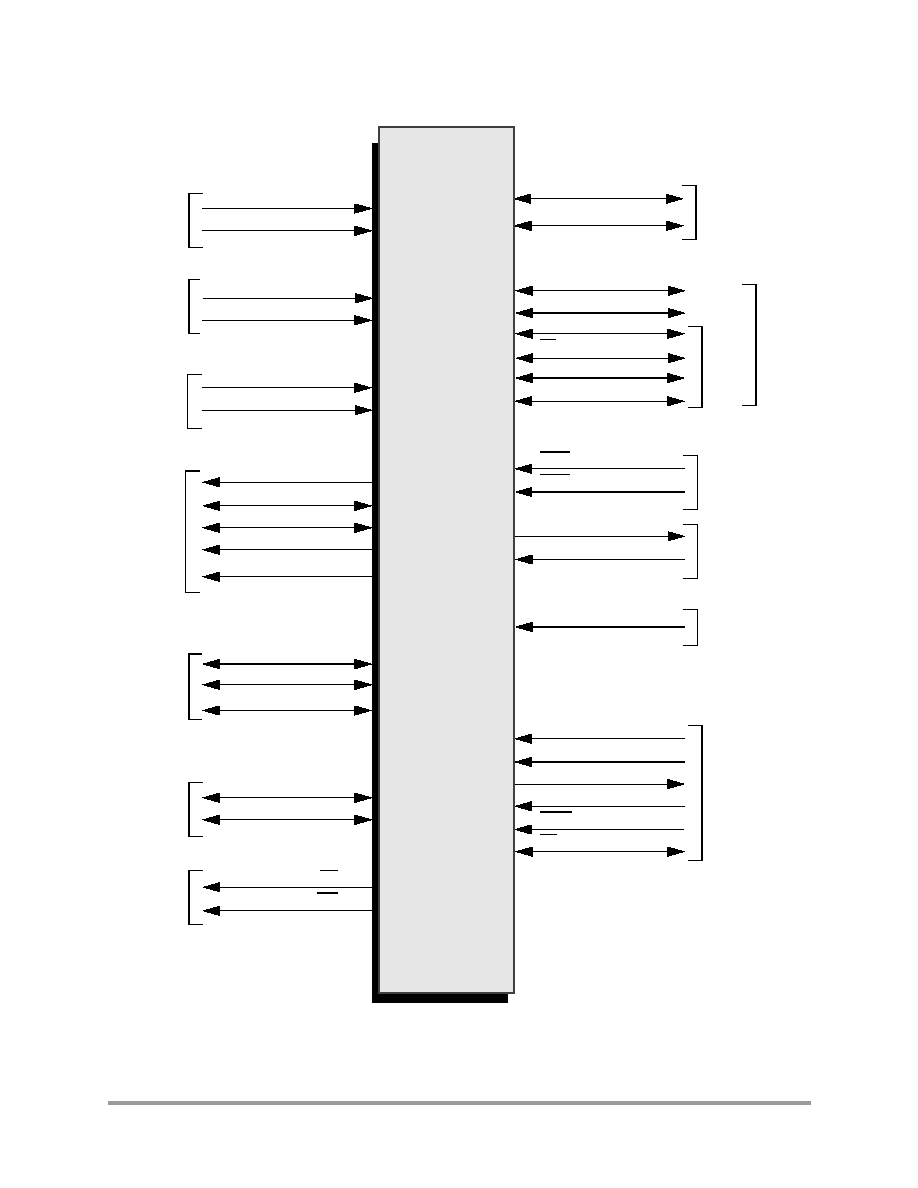
6
DSP56852 Preliminary Technical Data
MOTOROLA
Figure 2. DSP56852 Signals Identified by Functional Group
1. Specifically for PLL, OSC, and POR.
2. Alternate pin functions are shown in parentheses.
DSP56852
Logic
Power
I/O
Power
SCI
Reset
JTAG/Enhanced
OnCE
VDD
VSS
VDDIO
VSSIO
VDDA
VSSA
A0≠16
A17(TI/O)
A18(TI/O)
A19(CS3)
CLKO(A20)
GPIOA0(CS0)
GPIOA1(CS1)
GPIOA2(CS2)
D0-D12
D13-D15/MODEA-C
RD
WR
Bus
Control
RXD(GPIOE0)
TXD(GPIOE1)
GPIOC0(STXD)
GPIOC1(SRXD)
SCLK(GPIOC2)(STCK)
SS(GPIOC3)(STFS)
MISO(GPIOC4)(SRCK)
MOSI(GPIOC5)(SRFS)
IRQA
IRQB
XTAL
EXTAL
RESET
TCK
TDI
TDO
TMS
TRST
DE
SSI
SPI
Chip
Select
Address
Bus
Analog
Power
1
Interrupt
Request
Oscillator
Data
Bus
1
1
1
1
1
1
1
1
1
1
1
1
1
1
1
1
1
1
1
3
3
6
6
1
1
17
1
1
1
1
1
1
1
13
3
1
1

Introduction
MOTOROLA
DSP56852 Preliminary Technical Data
7
Part 3 Signals and Package Information
All digital inputs have a weak internal pull-up circuit associated with them. These pull-up circuits are
enabled by default. Exceptions:
1. When a pin has GPIO functionality, the pull-up may be disabled under software control.
2. Mode pins D13, D14 and D15 have no pull-up.
3. TCK has a weak pull-down circuit always active.
4. Bidirectional I/O pullups automatically disable when the output is enabled.
This table is presented consistently with the Signals Identified by Functional Group figure.
1. BOLD entries in the Type column represents the state of the pin just out of reset.
2. Ouput(Z) means an output in a High-Z condition.
Table 3. DSP56852 Signal and Package Information for the 81-pin MAPBGA
Pin No.
Signal Name
Type
Description
E1
V
DD
V
DD
Logic Power --These pins provide power to the internal
structures of the chip, and should all be attached to V
DD.
J5
V
DD
E9
V
DD
D1
V
SS
V
SS
Logic Power - GND--These pins provide grounding for the
internal structures of the chip and should all be attached to
V
SS.
J4
V
SS
F9
V
SS
C1
V
DDIO
V
DDIO
I/O Power --These pins provide power for all I/O and ESD
structures of the chip, and should all be attached to V
DDIO.
H1
V
DDIO
J7
V
DDIO
G9
V
DDIO
B9
V
DDIO
A4
V
DDIO
B1
V
SSIO
V
SSIO
I/O Power - GND--These pins provide grounding for all I/O
and ESD structures of the chip and should all be attached to
V
SS.
G1
V
SSIO
J6
V
SSIO
J9
V
SSIO
C9
V
SSIO
A5
V
SSIO
B5
V
DDA
V
DDA
Analog Power--These pins supply an analog power source
B6
V
SSA
V
SSA
Analog Ground--This pin supplies an analog ground.
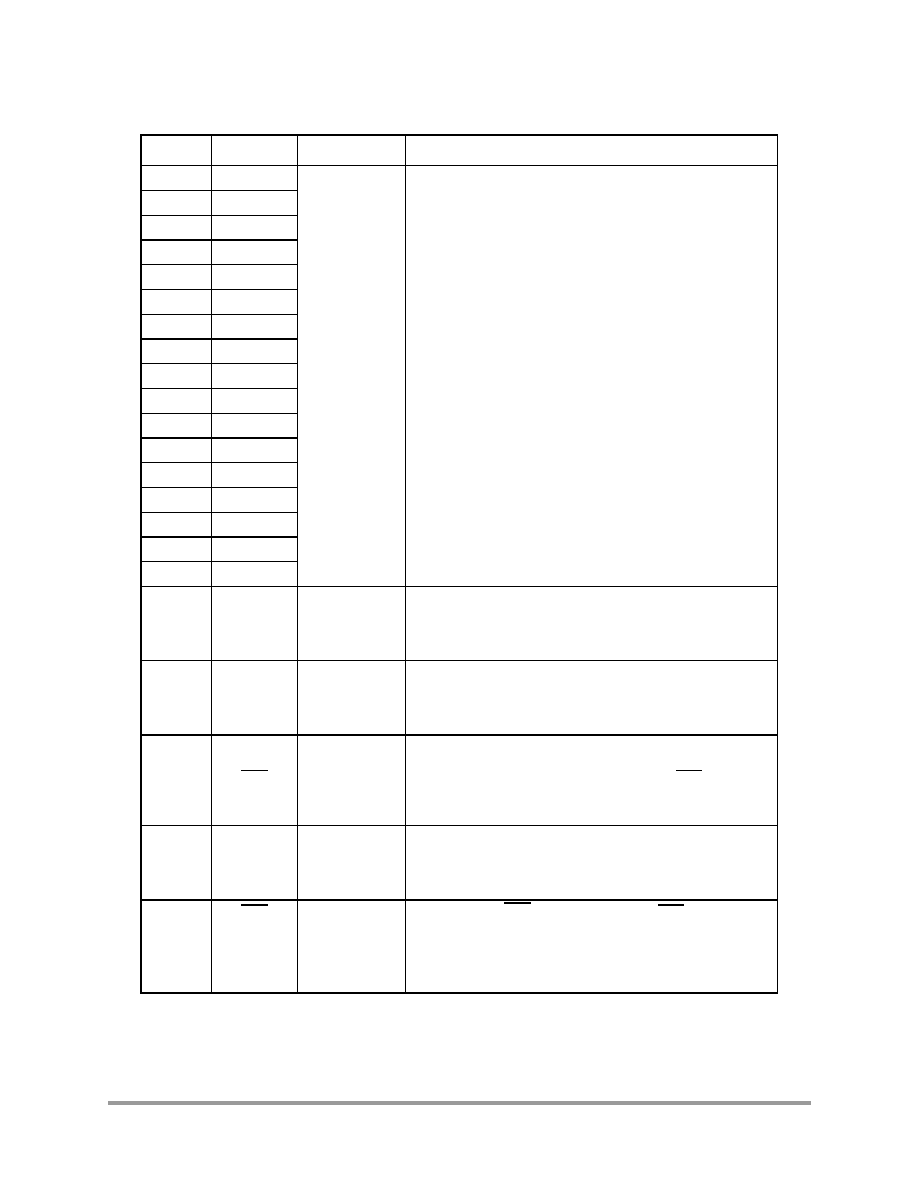
8
DSP56852 Preliminary Technical Data
MOTOROLA
E4
A0
Output(Z)
Address Bus (A0≠A16)--These pins specify a word
address for external program or data memory addresses.
F2
A1
F3
A2
F4
A3
F1
A4
G3
A5
G2
A6
J1
A7
H2
A8
H3
A9
J2
A10
H4
A11
G4
A12
J3
A13
F5
A14
H5
A15
E5
A16
F6
A17
TIO0
Output(Z)
Input/Output
Address Bus (A17)
Timer I/O (0)--Can be programmed as either a timer input
source or as a timer output flag.
G5
A18
TIO1
Output(Z)
Input/Output
Address Bus (A18)
Timer I/O (1)--Can be programmed as either a timer input
source or as a timer output flag.
H6
A19
CS3
Output(Z)
Output
Address Bus (A19)
External Chip Select 3 --When enabled, a CSx signal is
asserted for external memory accesses that fall within a
programmable address range.
J8
CLKO
A20
Output
Output
Output clock (CLKO)--User programmable clock out
reference
Address Bus--A20
D2
CS0
GPIOA0
Output
Input/Output
Chip Select 0 (CS0) --When enabled, a CSx signal is
asserted for external memory accesses that fall within a
programmable address range.
Port A GPIO (0) --A general purpose IO pin.
Table 3. DSP56852 Signal and Package Information for the 81-pin MAPBGA
Pin No.
Signal Name
Type
Description
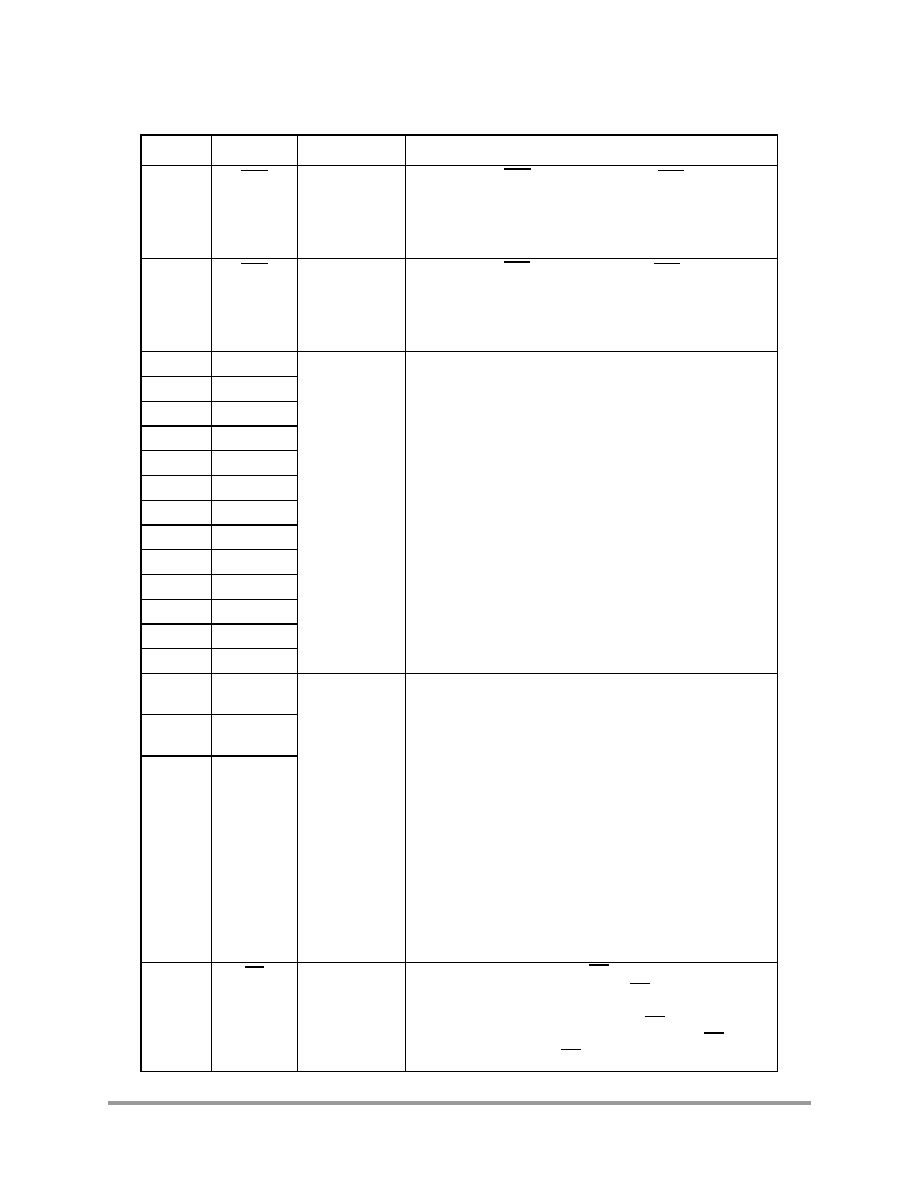
Introduction
MOTOROLA
DSP56852 Preliminary Technical Data
9
D3
CS1
GPIOA1
Output
Input/Output
Chip Select 1 (CS1) --When enabled, a CSx signal is
asserted for external memory accesses that fall within a
programmable address range.
Port A GPIO (1) --A general purpose IO pin.
C3
CS2
GPIOA2
Output
Input/Output
Chip Select 2 (CS2)--When enabled, a CSx signal is
asserted for external memory accesses that fall within a
programmable address range.
Port A GPIO (2) --A general purpose IO pin.
G7
D0
Input/Output
Data Bus (D0≠D12) --specify the data for external program or
data memory accesses. D0≠D15 are tri-stated when the
external bus is inactive.
H7
D1
H8
D2
G8
D3
H9
D4
F8
D5
F7
D6
G6
D7
E8
D8
E7
D9
E6
D10
D8
D11
D7
D12
D9
D13
MODE A
Input/Output
Data Bus (D13≠D15) -- specify the data for external program
or data memory accesses. D0≠D15 are tri-stated when the
external bus is inactive.
Mode Select--During the bootstrap process the MODE A,
MODE B, and MODE C pins select one of the eight
bootstrap modes. These pins are sampled at the end of
reset.
Note: Any time POR and EXTERNAL resets are active, the
state of MODE A, B and C pins get asynchronously
transferred to the SIM Control Register [14:12] ($1FFF08)
respectively. These bits determine the mode in which the
part will boot up.
Note: Software and COP resets do not update the SIM
Control Register.
C8
D14
MODE B
A9
D15
MODE C
E2
RD
Output
Bus Control≠ Read Enable (RD)--is asserted during
external memory read cycles. When RD is asserted low,
pins D0≠D15 become inputs and an external device is
enabled onto the DSP data bus. When RD is deasserted
high, the external data is latched inside the DSP. RD can be
connected directly to the OE pin of a Static RAM or ROM.
Table 3. DSP56852 Signal and Package Information for the 81-pin MAPBGA
Pin No.
Signal Name
Type
Description

10
DSP56852 Preliminary Technical Data
MOTOROLA
E3
WR
Output
Bus Control≠Write Enable (WR)-- is asserted during
external memory write cycles. When WR is asserted low,
pins D0≠D15 become outputs and the DSP puts data on the
bus. When WR is deasserted high, the external data is
latched inside the external device. When WR is asserted, it
qualifies the A0≠A15 pins. WR can be connected directly to
the WE pin of a Static RAM.
B4
RXD
GPIOE0
Input
Input/Output
SCI Receive Data (RXD)--This input receives byte-
oriented serial data and transfers it to the SCI receive shift
register.
Port E GPIO (0)--A general purpose I/O pin.
D4
TXD
GPIOE1
Output(Z)
Input/Output
SCI Transmit Data (TXD)--This signal transmits data from
the SCI transmit data register.
Port E GPIO (1)--A general purpose I/O pin.
B2
GPIOC0
STXD
Input/Output
Output
Port C GPIO (0)--This pin is a General Purpose I/O (GPIO)
pin when the SSI is not in use.
SSI Transmit Data (STXD)--This output pin transmits serial
data from the SSI Transmitter Shift Register.
A2
GPIOC1
SRXD
Input/Output
Input
Port C GPIO (1)--This pin is a General Purpose I/O (GPIO)
pin when the SSI is not in use.
SSI Receive Data (SRXD)--This input pin receives serial
data and transfers the data to the SSI Receive Shift
Register.
A3
SCLK
GPIOC2
STCK
Input/Output
Input/Output
Input/Output
SPI Serial Clock (SCLK)--In Master mode, this pin serves
as an output, clocking slaved listeners. In Slave mode, this
pin serves as the data clock input.
Port C GPIO (2)--This pin is a General Purpose I/O (GPIO)
pin that can individually be programmed as input or output
pin.
SSI Serial Transfer Clock (STCK)--This bidirectional pin
provides the serial bit rate clock for the transmit section of
the SSI. The clock signal can be continuous or gated.
B3
SS
GPIOC3
STFS
Input
Input/Output
Input/Output
SPI Slave Select (SS)--In Master mode, this pin is used to
arbitrate multiple masters. In Slave mode, this pin is used to
select the slave.
Port C GPIO (3)--This pin is a General Purpose I/O (GPIO)
pin that can individually be programmed as input or output
pin.
SSI Serial Transfer Frame Sync (STFS) --This
bidirectional pin is used to count the number of words in a
frame while transmitting. A programmable frame rate divider
and a word length divider are used for frame rate sync signal
generation.
Table 3. DSP56852 Signal and Package Information for the 81-pin MAPBGA
Pin No.
Signal Name
Type
Description

Introduction
MOTOROLA
DSP56852 Preliminary Technical Data
11
C4
MISO
GPIOC4
SRCK
Input/Output
Input/Output
Input/Output
SPI Master In/Slave Out (MISO)--This serial data pin is an
input to a master device and an output from a slave device.
The MISO line of a slave device is placed in the high-
impedance state if the slave device is not selected.
Port C GPIO (4)--This pin is a General Purpose I/O (GPIO)
pin that can individually be programmed as input or output
pin.
SSI Serial Receive Clock (SRCK)--This bidirectional pin
provides the serial bit rate clock for the receive section of the
SSI. The clock signal can be continuous or gated.
C5
MOSI
GPIOC5
SRFS
Input/
Output (Z)
Input/Output
Input/Output
SPI Master Out/Slave In (MOSI)--This serial data pin is an
output from a master device and an input to a slave device.
The master device places data on the MOSI line a half-cycle
before the clock edge that the slave device uses to latch the
data.
Port C GPIO (5)--This pin is a General Purpose I/O (GPIO)
pin that can individually be programmed as input or output
pin.
SSI Serial Receive Frame Sync (SRFS)-- This
bidirectional pin is used to count the number of words in a
frame while receiving. A programmable frame rate divider
and a word length divider are used for frame rate sync signal
generation.
A1
IRQA
Input
External Interrupt Request A (IRQA)--The IRQA Schmitt
trigger input is a synchronized external interrupt request that
indicates that an external device is requesting service. It can
be programmed to be level-sensitive or negative-edge-
triggered.
C2
IRQB
Input
External Interrupt Request B (IRQB)--The IRQB Schmitt
trigger input is an external interrupt request that indicates
that an external device is requesting service. It can be
programmed to be level-sensitive or negative-edge-
triggered.
A6
EXTAL
Input
External Crystal Oscillator Input (EXTAL)--This input
should be connected to an external crystal. If an external
clock source other than a crystal oscillator is used, EXTAL
must be tied off.
A7
XTAL
Input/Output
Crystal Oscillator Output (XTAL)--This output connects
the internal crystal oscillator output to an external crystal. If
an external clock source other than a crystal oscillator is
used, XTAL must be used as the input.
Table 3. DSP56852 Signal and Package Information for the 81-pin MAPBGA
Pin No.
Signal Name
Type
Description
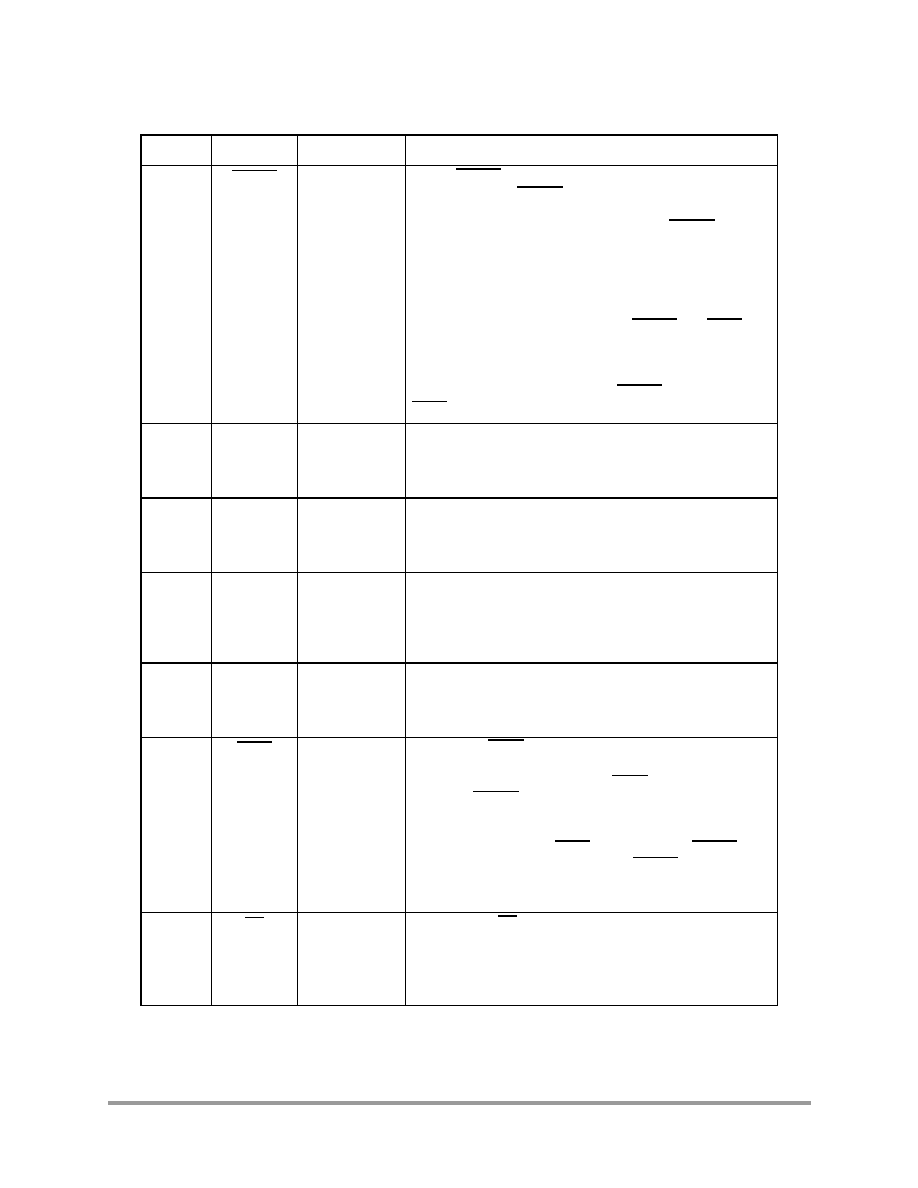
12
DSP56852 Preliminary Technical Data
MOTOROLA
D5
RESET
Input
Reset (RESET)--This input is a direct hardware reset on the
processor. When RESET is asserted low, the DSP is
initialized and placed in the Reset state. A Schmitt trigger
input is used for noise immunity. When the RESET pin is
deasserted, the initial Chip Operating mode is latched from
the D[15:13] pins. The internal reset signal will be
deasserted synchronous with the internal clocks, after a
fixed number of internal clocks.
To ensure complete hardware reset, RESET and TRST
should be asserted together. The only exception occurs in a
debugging environment when a hardware DSP reset is
required and it is necessary not to reset the JTAG/Enhanced
OnCE module. In this case, assert RESET, but do not assert
TRST.
C6
TCK
Input
Test Clock Input (TCK)--This input pin provides a gated
clock to synchronize the test logic and shift serial data to the
JTAG/Enhanced OnCE port. The pin is connected internally
to a pull-down resistor.
B7
TDI
Input
Test Data Input (TDI)--This input pin provides a serial input
data stream to the JTAG/Enhanced OnCE port. It is sampled
on the rising edge of TCK and has an on-chip pull-up
resistor.
A8
TDO
Output
Test Data Output (TDO)--This tri-statable output pin
provides a serial output data stream from the JTAG/
Enhanced OnCE port. It is driven in the Shift-IR and Shift-
DR controller states, and changes on the falling edge of
TCK.
C7
TMS
Input
Test Mode Select Input (TMS)--This input pin is used to
sequence the JTAG TAP controller's state machine. It is
sampled on the rising edge of TCK and has an on-chip pull-
up resistor.
D6
TRST
Input
Test Reset (TRST)--As an input, a low signal on this pin
provides a reset signal to the JTAG TAP controller. To
ensure complete hardware reset, TRST should be asserted
whenever RESET is asserted. The only exception occurs in
a debugging environment, since the Enhanced OnCE/JTAG
module is under the control of the debugger. In this case it is
not necessary to assert TRST when asserting RESET .
Outside of a debugging environment RESET should be
permanently asserted by grounding the signal, thus
disabling the Enhanced OnCE/JTAG module on the DSP.
B8
DE
Input/Output
Debug Even (DE)-- is an open-drain, bidirectional, active
low signal. As an input, it is a means of entering Debug
mode of operation from an external command controller. As
an output, it is a means of acknowledging that the chip has
entered Debug mode.
Table 3. DSP56852 Signal and Package Information for the 81-pin MAPBGA
Pin No.
Signal Name
Type
Description

General Characteristics
MOTOROLA
DSP56852 Preliminary Technical Data
13
Part 4 Specifications
4.1 General Characteristics
The DSP56852 is fabricated in high-density CMOS with 5-volt tolerant TTL-compatible digital inputs.
The term "5-volt tolerant" refers to the capability of an I/O pin, built on a 3.3V compatible process
technology, to withstand a voltage up to 5.5V without damaging the device. Many systems have a mixture
of devices designed for 3.3V and 5V power supplies. In such systems, a bus may carry both 3.3V and 5V-
compatible I/O voltage levels (a standard 3.3V I/O is designed to receive a maximum voltage of 3.3V
±10% during normal operation without causing damage). This 5V-tolerant capability therefore offers the
power savings of 3.3V I/O levels while being able to receive 5V levels without being damaged.
Absolute maximum ratings given in
Table 4
are stress ratings only, and functional operation at the
maximum is not guaranteed. Stress beyond these ratings may affect device reliability or cause permanent
damage to the device.
The DSP56852 DC/AC electrical specifications are preliminary and are from design simulations. These
specifications may not be fully tested or guaranteed at this early stage of the product life cycle. Finalized
specifications will be published after complete characterization and device qualifications have been
completed.
CAUTION
This device contains protective circuitry to guard
against damage due to high static voltage or
electrical fields. However, normal precautions are
advised to avoid application of any voltages higher
than maximum rated voltages to this high-impedance
circuit. Reliability of operation is enhanced if unused
inputs are tied to an appropriate voltage level.
Table 4. Absolute Maximum Ratings
Characteristic
Symbol
Min
Max
Unit
Supply voltage, core
V
DD
1
1.
V
DD
must not exceed V
DDIO
V
SS
≠ 0.3
V
SS
+ 2.0
V
Supply voltage, IO
Supply voltage, analog
V
DDIO
2
V
DDIO
2
2.
V
DDIO
and V
DDA
must not differ by more that 0.5V
V
SSIO
≠ 0.3
V
SSA
≠ 0.3
V
SSIO
+ 4.0
V
DDA
+ 4.0
V
Digital input voltages
Analog input voltages (XTAL, EXTAL)
V
IN
V
INA
V
SSIO
≠ 0.3
V
SSA
≠ 0.3
V
SSIO
+ 5.5
V
DDA
+ 0.3
V
Current drain per pin excluding V
DD
, V
SS,
V
DDA
,
V
SSA,
V
DDIO
, V
SSIO
I
--
10
mA
Junction temperature
T
J
-40
120
∞C
Storage temperature range
T
STG
-55
150
∞C

14
DSP56852 Preliminary Technical Data
MOTOROLA
4.2 DC Electrical Characteristics
Table 5. Recommended Operating Conditions
Characteristic
Symbol
Min
Max
Unit
Supply voltage for Logic Power
V
DD
1.62
1.98
V
Supply voltage for I/O Power
V
DDIO
3.0
3.6
V
Supply voltage for Analog Power
V
DDA
3.0
3.6
V
Ambient operating temperature
T
A
-40
85
∞C
PLL clock frequency
1
1.
Assumes clock source is direct clock to EXTAL or crystal oscillator running 2-4MHz PLL must be enabled, locked, and
selected. The actual frequency depends on the source clock frequency and programming of the CGM module.
f
pll
--
240
MHz
Operating Frequency
2
2.
Master clock is derived from one of the following four sources:
f
clk
= f
xtal
when the source clock is the direct clock to EXAL
f
clk
= f
pll
when PLL is selected
f
clk
= f
osc
when the source clock is the crystal oscillator and PLL is not selected
f
clk
= f
extal
when the source clock is the direct clock to EXAL and PLL is not selected
f
op
--
120
MHz
Frequency of peripheral bus
f
ipb
--
60
MHz
Frequency of external clock
f
clk
--
240
MHz
Frequency of oscillator
f
osc
2
4
MHz
Frequency of clock via XTAL
f
xtal
--
240
MHz
Frequency of clock via EXTAL
f
extal
2
4
MHz
Table 6. Thermal Characteristics
1
1.
See
Section 6.1
for more detail.
Characteristic
81-pin MAPBGA
Symbol
Value
Unit
Thermal resistance junction-to-ambient
(estimated)
JA
36.9
∞C/W
I/O pin power dissipation
P
I/O
User Determined
W
Power dissipation
P
D
P
D
= (I
DD
◊
V
DD
) + P
I/O
W
Maximum allowed P
D
P
DMAX
(T
J
≠ T
A
) /
JA
∞
C
Table 7. DC Electrical Characteristics
Operating Conditions: V
SS
= V
SSIO
= V
SSA
= 0V, V
DD
= 1.62-1.98V, V
DDIO
= V
DDA
= 3.0≠3.6V, T
A
= ≠40
∞
to +120
∞
C, C
L
50pF, f
op
= 120MHz
Characteristic
Symbol
Min
Typ
Max
Unit
Input high voltage (XTAL/EXTAL)
V
IHC
V
DDA
≠ 0.8
V
DDA
V
DDA
+ 0.3
V

DC Electrical Characteristics
MOTOROLA
DSP56852 Preliminary Technical Data
15
Input low voltage (XTAL/EXTAL)
V
ILC
-0.3
--
0.5
V
Input high voltage
V
IH
2.0
--
5.5
V
Input low voltage
V
IL
-0.3
--
0.8
V
Input current low (pullups disabled)
I
IL
-1
--
1
µ
A
Input current high (pullups disabled)
I
IH
-1
--
1
µ
A
Output tri-state current low
I
OZL
-10
--
10
µ
A
Output tri-state current high
I
OZH
-10
--
10
µ
A
Output High Voltage at I
OH
V
OH
V
DDIO
≠ 0.7
--
--
V
Output Low Voltage at I
OL
V
OL
--
--
0.4
V
Output High Current at V
OH
I
OH
8
--
16
mA
Output Low Current at V
OL
I
OL
8
--
16
mA
Input capacitance
C
IN
--
8
--
pF
Output capacitance
C
OUT
--
12
--
pF
V
DD
supply current @ nominal voltage and 25
∞
C
Run
1
Deep Stop
2
Light Stop
3
I
DD
4
--
--
--
70
30
2.6
--
--
--
mA
µ
A
mA
V
DDIO
supply current @ nominal voltage and 25
∞
C
Run
5
I
DDIO
--
40
--
mA
V
DDA
supply current @ nominal voltage and 25
∞
C
Deep Stop
2
I
DDA
--
60
--
µ
A
Low Voltage Interrupt
6
V
EI
--
2.5
2.85
V
Low Voltage Interrupt Recovery Hysteresis
V
EIH
--
50
--
mV
Power on Reset
7
POR
--
1.5
2.0
V
1.
Run (operating) I
DD
measured using external square wave clock source (f
osc
= 4MHz) into XTAL. All inputs 0.2V from
rail; no DC loads; outputs unloaded. All ports configured as inputs; measured with all modules enabled. PLL set to 240MHz
out. Running Core, performing 50% NOP and 50% FIR. Clock at 120 MHz.
2.
Deep Stop Mode - Operation frequency = 4 MHz, PLL set to 4 MHz, crystal oscillator and time of day module operating.
3.
Light Stop Mode - Operation frequency = 120 MHz, PLL set to 240 MHz, crystal oscillator and time of day module oper-
ating.
4.
I
DD
includes current for core logic, internal memories, and all internal peripheral logic circuitry.
5.
Running core and performing external memory access. Clock at 120 MHz.
6.
When V
DD
drops below V
EI
max value, an interrupt is generated.
7.
Power-on reset occurs whenever the digital supply drops below 1.8V. While power is ramping up, this signal remains
active as long as the internal 2.5V is below 1.8V, no matter how long the ramp up rate is. The internally regulated voltage is
typically 100mV less than V
DD
during ramp up until 2.5V is reached, at which time it self-regulates.
Table 7. DC Electrical Characteristics (Continued)
Operating Conditions: V
SS
= V
SSIO
= V
SSA
= 0V, V
DD
= 1.62-1.98V, V
DDIO
= V
DDA
= 3.0≠3.6V, T
A
= ≠40
∞
to +120
∞
C, C
L
50pF, f
op
= 120MHz
Characteristic
Symbol
Min
Typ
Max
Unit

16
DSP56852 Preliminary Technical Data
MOTOROLA
4.3 Supply Voltage Sequencing and Separation Cautions
Figure 3
shows two situations to avoid in sequencing the V
DD
and V
DDIO,
V
DDA
supplies.
Notes: 1. V
DD
rising before V
DDIO
, V
DDA
2. V
DDIO
, V
DDA
rising much faster than V
DD
Figure 3. Supply Voltage Sequencing and Separation Cautions
V
DD
should not be allowed to rise early (1). This is usually avoided by running the regulator for the V
DD
supply (1.8V) from the voltage generated by the 3.3V V
DDIO
supply, see
Figure 4
. This keeps V
DD
from
rising faster than V
DDIO
.
V
DD
should not rise so late that a large voltage difference is allowed between the two supplies (2). Typically
this situation is avoided by using external discrete diodes in series between supplies, as shown in
Figure 4
.
The series diodes forward bias when the difference between V
DDIO
and V
DD
reaches approximately 2.1,
causing V
DD
to rise as V
DDIO
ramps up. When the V
DD
regulator begins proper operation, the difference
between supplies will typically be 0.8V and conduction through the diode chain reduces to essentially
leakage current. During supply sequencing, the following general relationship should be adhered to:
V
DDIO
> V
DD
> (V
DDIO
- 2.1V)
In practice, V
DDA
is typically connected directly to V
DDIO
with some filtering.
Figure 4. Example Circuit to Control Supply Sequencing
3.3V
1.8V
Time
0
2
1
Supplies Stable
V
DD
V
DDIO,
V
DDA
DC Power
Supp
ly V
o
l
t
a
ge
3.3V
Regulator
1.8V
Regulator
Supply
V
DD
V
DDIO,
V
DDA
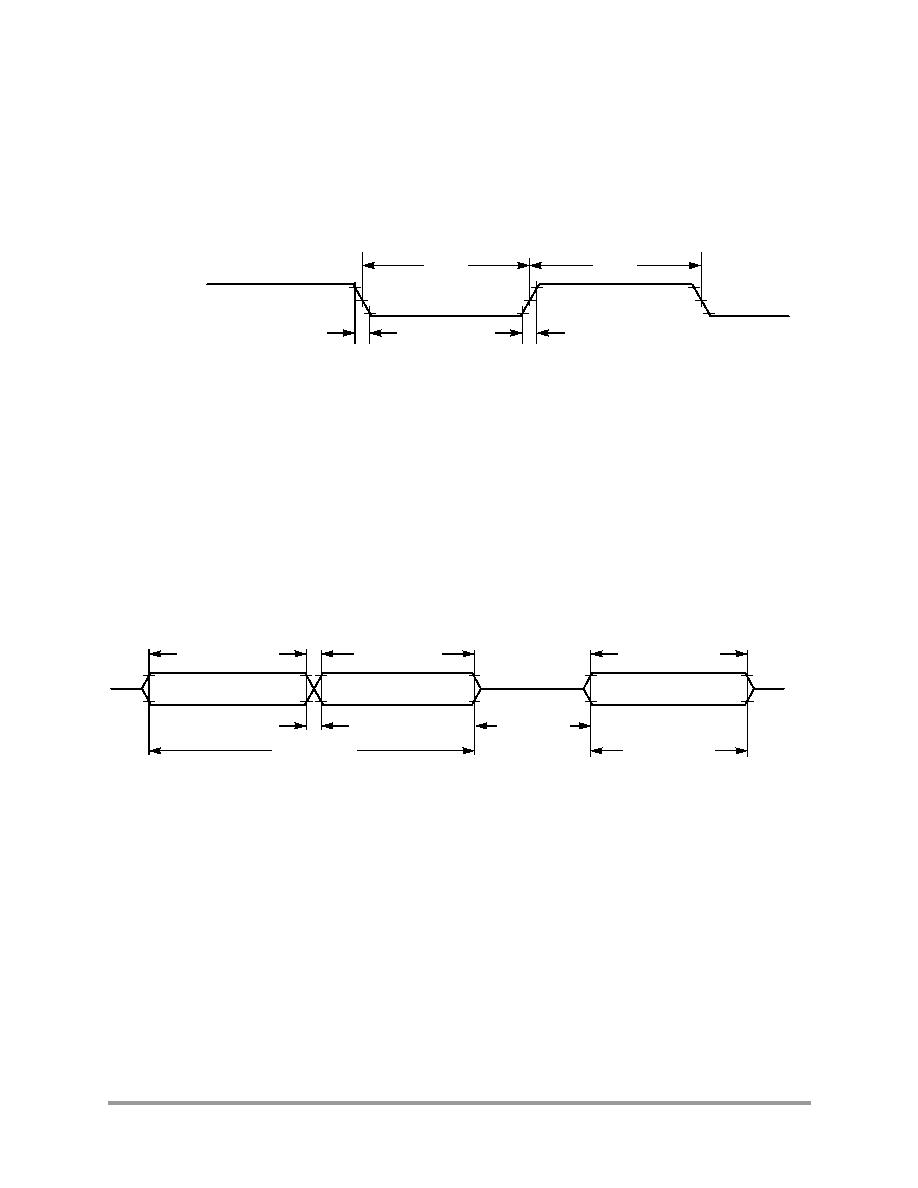
AC Electrical Characteristics
MOTOROLA
DSP56852 Preliminary Technical Data
17
4.4 AC Electrical Characteristics
Timing waveforms in
Section 4.2
are tested with a V
IL
maximum of 0.8V and a V
IH
minimum of 2.0V for
all pins except XTAL, which is tested using the input levels in
Section 4.2
. In
Figure 5
the levels of V
IH
and V
IL
for an input signal are shown.
Figure 5. Input Signal Measurement References
Figure 6
shows the definitions of the following signal states:
∑
Active state, when a bus or signal is driven, and enters a low impedance state
∑
Tri-stated, when a bus or signal is placed in a high impedance state
∑
Data Valid state, when a signal level has reached V
OL
or V
OH
∑
Data Invalid state, when a signal level is in transition between V
OL
and V
OH
Figure 6. Signal States
4.5 External Clock Operation
The DSP56852 system clock can be derived from a crystal or an external system clock signal. To generate
a reference frequency using the internal oscillator, a reference crystal must be connected between the
EXTAL and XTAL pins.
4.5.1
Crystal Oscillator for use with PLL
The internal oscillator is designed to interface with a parallel-resonant crystal resonator in the frequency
range specified for the external crystal in
Table 9
. In
Figure 7
a typical crystal oscillator circuit is shown.
Follow the crystal supplier's recommendations when selecting a crystal, because crystal parameters
determine the component values required to provide maximum stability and reliable start-up. The crystal
and associated components should be mounted as close as possible to the EXTAL and XTAL pins to
minimize output distortion and start-up stabilization time.
V
IH
V
IL
Fall Time
Input Signal
Note: The midpoint is V
IL
+ (V
IH
≠ V
IL
)/2.
Midpoint1
Low
High
90%
50%
10%
Rise Time
Data Invalid State
Data1
Data2 Valid
Data
Tri-stated
Data3 Valid
Data2
Data3
Data1 Valid
Data Active
Data Active

18
DSP56852 Preliminary Technical Data
MOTOROLA
Figure 7. Crystal Oscillator
4.5.2
High Speed External Clock Source (> 4MHz)
The recommended method of connecting an external clock is given in
Figure 8
. The external clock source
is connected to XTAL and the EXTAL pin is held at ground, V
DDA
, or V
DDA
/2. The TOD_SEL bit in
CGM must be set to 0.
Figure 8. Connecting a High Speed External Clock Signal using XTAL
4.5.3
Low Speed External Clock Source (2-4MHz)
The recommended method of connecting an external clock is given in
Figure 9
. The external clock source
is connected to XTAL and the EXTAL pin is held at V
DDA
/2. The TOD_SEL bit in CGM must be set to 0.
Figure 9. Connecting a Low Speed External Clock Signal using XTAL
Sample External Crystal Parameters:
R
z
= 10M
TOD_SEL bit in CGM must be set to 0
Crystal Frequency = 2≠4MHz (optimized for 4MHz)
EXTAL XTAL
R
z
DSP56852
XTAL
EXTAL
External
GND,
V
DDA
,
Clock
(up to 240MHz)
or V
DDA
/2
DSP56852
XTAL
EXTAL
External
Clock
(2-4MHz)
V
DDA
/2
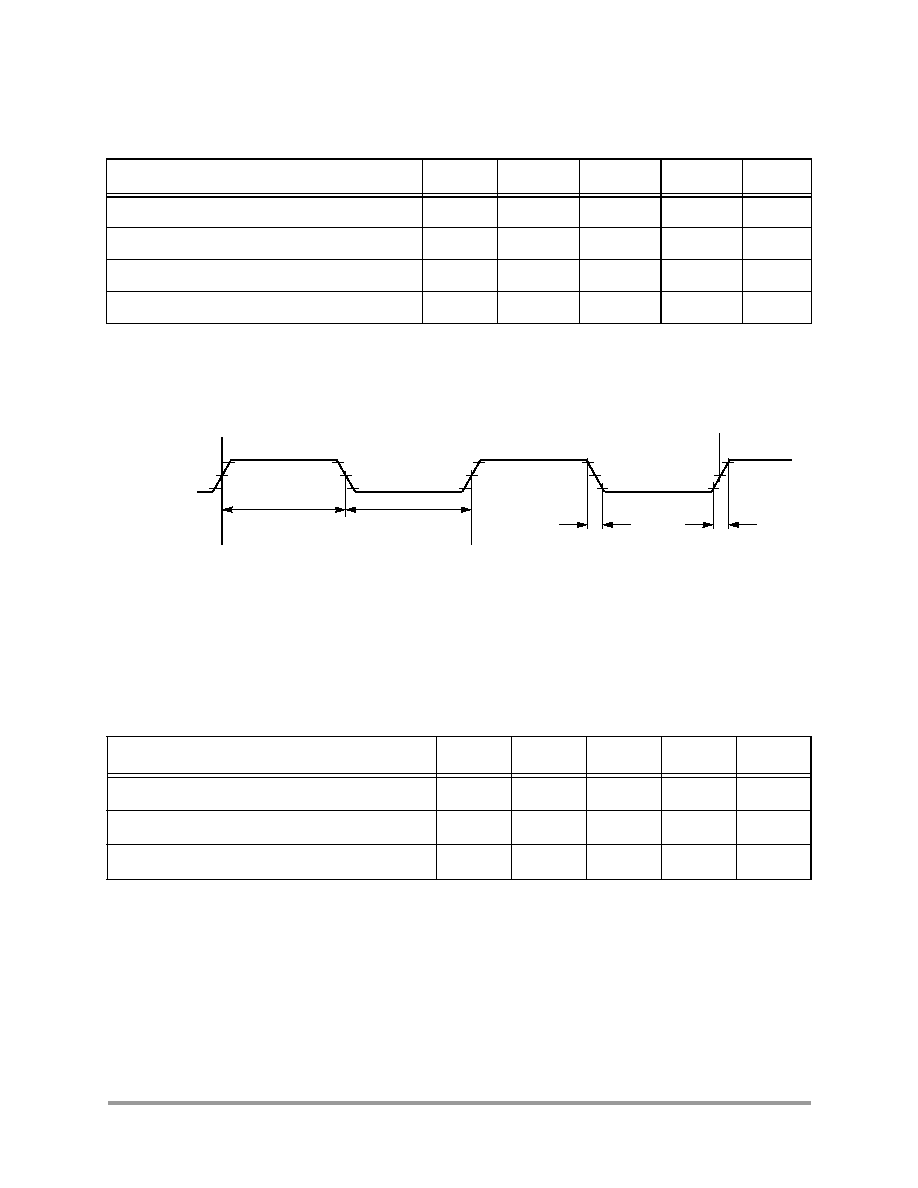
External Clock Operation
MOTOROLA
DSP56852 Preliminary Technical Data
19
Figure 10. External Clock Timing
Table 8. External Clock Operation Timing Requirements
4
Operating Conditions: V
SS
= V
SSIO
= V
SSA
= 0V, V
DD
= 1.62-1.98V, V
DDIO
= V
DDA
= 3.0≠3.6V, T
A
= ≠40
∞
to +120
∞
C, C
L
50pF, f
op
= 120MHz
Characteristic
Symbol
Min
Typ
Max
Unit
Frequency of operation (external clock driver)
1
1.
See
Figure 8
for details on using the recommended connection of an external clock driver.
f
osc
0
--
240
MHz
Clock Pulse Width
4
t
PW
6.25
--
--
ns
External clock input rise time
2,
4
2.
External clock input rise time is measured from 10 to 90 percent.
t
rise
--
--
TBD
ns
External clock input fall time
3,
4
3.
External clock input fall time is measured from 90 to 10percent.
4.
Parameters listed are guaranteed by design.
t
fall
--
--
TBD
ns
Table 9. PLL Timing
Operating Conditions: V
SS
= V
SSIO
= V
SSA
= 0V, V
DD
= 1.62-1.98V, V
DDIO
= V
DDA
= 3.0≠3.6V, T
A
= ≠40
∞
to +120
∞
C, C
L
50pF, f
op
= 120MHz
Characteristic
Symbol
Min
Typ
Max
Unit
External reference crystal frequency for the PLL
1
1.
An externally supplied reference clock should be as free as possible from any phase jitter for the PLL to work correctly.
The PLL is optimized for 4MHz input crystal.
f
osc
2
4
4
MHz
PLL output frequency
f
clk
40
--
240
MHz
PLL stabilization time
2
2.
This is the minimum time required after the PLL setup is changed to ensure reliable operation.
t
plls
--
1
10
ms
External
Clock
V
IH
V
IL
Note: The midpoint is V
IL
+ (V
IH
≠ V
IL
)/2.
90%
50%
10%
90%
50%
10%
t
PW
t
PW
t
fall
t
rise
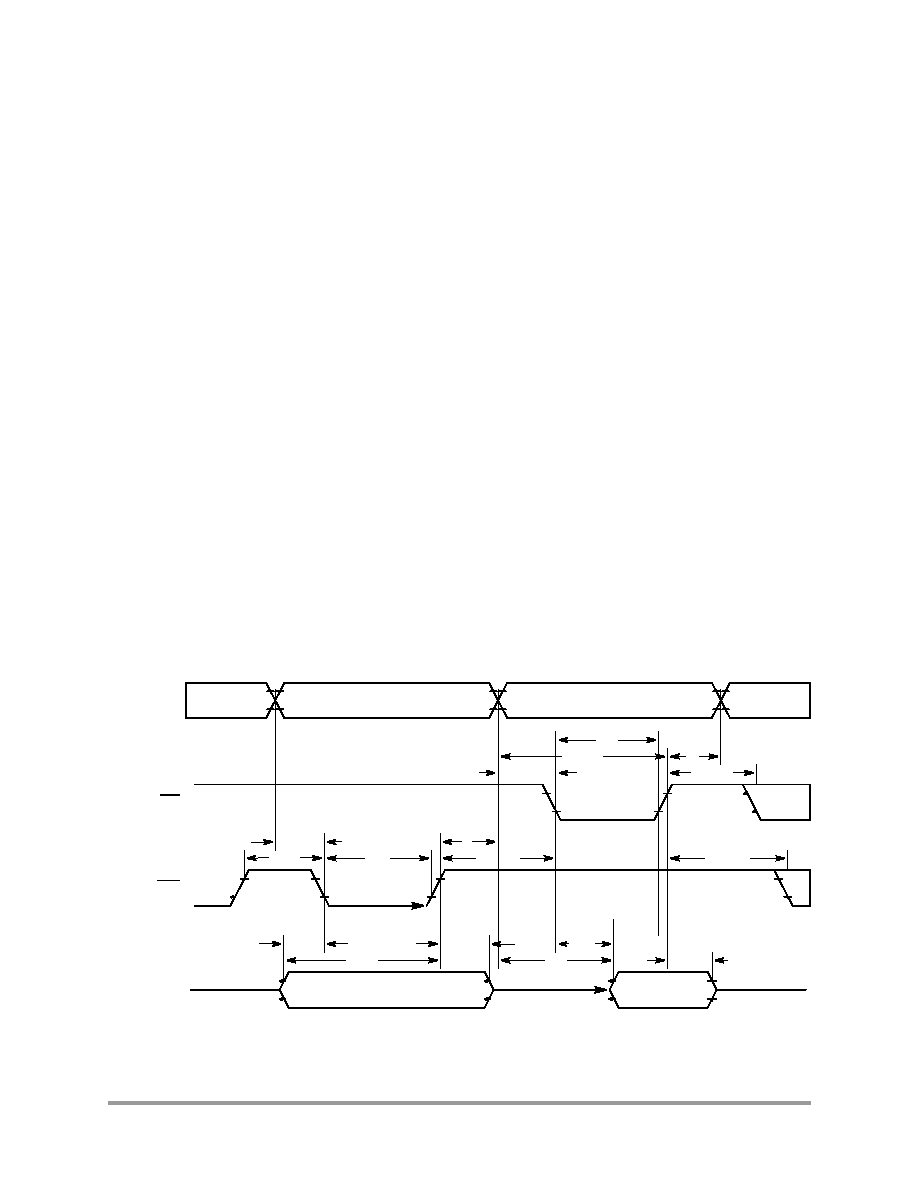
20
DSP56852 Preliminary Technical Data
MOTOROLA
4.6 External Memory InterfaceTiming
The External Memory Interface is designed to access static memory and peripheral devices.
Figure 11
shows sample timing and parameters that are detailed in
Table 10
.
The timing of each parameter consists of both a fixed delay portion and a clock related portion; as well as
user controlled wait states. The equation:
t = D + P * (M + W)
should be used to determine the actual time of each parameter. The terms in the above equation are
defined as:
t
parameter delay time
D
fixed portion of the delay, due to on-chip path delays.
P
the period of the system clock, which determines the execution rate of the part (i.e. when the
device is operating at 120 MHz, P = 8.33 ns).
M Fixed portion of a clock period inherent in the design. This number is adjusted to account for
possible clock duty cycle derating.
W the sum of the applicable wait state controls. See the "Wait State Controls" column of
Table 10
for the applicable controls for each parameter. See the EMI chapter of the 83x
Peripheral Manual for details of what each wait state field controls.
Some of the parameters contain two sets of numbers. These parameters have two different paths and clock
edges that must be considered. Check both sets of numbers and use the smaller result. The appropriate
entry may change if the operating frequency of the part changes.
The timing of write cycles is different when WWS = 0 than when WWS > 0. Therefore, some parameters
contain two sets of numbers to account for this difference. The "Wait States Configuration" column of
Table 10
should be used to make the appropriate selection.
Figure 11. External Memory Interface Timing
t
DRD
t
RDD
t
AD
t
DOH
t
DOS
t
DWR
t
RDWR
t
WAC
t
WRRD
t
WR
t
AWR
t
WRWR
t
ARDD
t
RDA
t
RDRD
t
RD
t
ARDA
Data Out
Data In
A0-Axx,CS
RD
WR
D0-D15
Note: During read-modify-write instructions and internal instructions, the address lines do not change state.

External Memory InterfaceTiming
MOTOROLA
DSP56852 Preliminary Technical Data
21
Table 10. External Memory Interface Timing
Operating Conditions: V
SS
= V
SSIO
= V
SSA
= 0 V, V
DD
= 1.62-1.98 V, V
DDIO
= V
DDA
=
3.0≠3.6V, T
A
= ≠40
∞ to +120∞C, C
L
50pF, P = 8.333ns
Characteristic
Symbol
Wait States
Configuration
D
M
Wait States
Controls
Unit
Address Valid to WR Asserted
t
AWR
WWS=0 -0.75
0.50
WWSS
ns
WWS>0
-1.50
0.69
WR Width Asserted to WR
Deasserted
t
WR
WWS=0 -0.52
0.19
WWS
ns
WWS>0
-0.13
0.00
Data Out Valid to WR Asserted
t
DWR
WWS=0
-1.86
0.00
WWSS
ns
WWS=0 -
6.03
0.25
WWS>0
-1.73
0.19
WWS>0
-4.29
0.50
Valid Data Out Hold Time after WR
Deasserted
t
DOH
-1.71
0.25
WWSH
ns
Valid Data Out Set Up Time to WR
Deasserted
t
DOS
-2.38
0.19
WWS,WWSS
ns
-4.42
0.50
Valid Address after WR
Deasserted
t
WAC
-1.44
0.25
WWSH
RD Deasserted to Address Invalid
t
RDA
- 0.51
0.00
RWSH
ns
Address Valid to RD Deasserted
t
ARDD
-2.03
1.00
RWSS,RWS
ns
Valid Input Data Hold after RD
Deasserted
t
DRD
0.00
N/A
1
1.
N/A since device captures data before it deasserts RD
--
ns
RD Assertion Width
t
RD
-0.97
1.00
RWS
ns
Address Valid to Input Data Valid
t
AD
-10.13
1.00
RWSS,RWS
ns
-13.22
1.19
Address Valid to RD Asserted
t
ARDA
- 1.06
0.00
RWSS
ns
RD Asserted to Input Data Valid
t
RDD
-9.06
1.00
RWSS,RWS
ns
-12.65
1.19
WR Deasserted to RD Asserted
t
WRRD
-0.70
0.25
WWSH,RWSS
ns
RD Deasserted to RD Asserted
t
RDRD
-0.17
2
2.
If RWSS = RWSH = 0, RD does not deassert during back-to-back reads and D=0.00 should be used.
0.00
RWSS,RWSH
ns
WR Deasserted to WR Asserted
t
WRWR
WWS=0
-0.47
0.75
WWSS, WWSH
ns
WWS>0
-0.07
1.00
RD Deasserted to WR Asserted
t
RDWR
0.10
0.50
MDAR, BMDAR,
RWSH, WWSS
ns
-0.31
0.69

22
DSP56852 Preliminary Technical Data
MOTOROLA
4.7 Reset, Stop, Wait, Mode Select, and Interrupt Timing
Table 11. Reset, Stop, Wait, Mode Select, and Interrupt Timing
1, 2
Operating Conditions: V
SS
= V
SSIO
= V
SSA
= 0V, V
DD
= 1.62-1.98V, V
DDIO
= V
DDA
= 3.0≠3.6V, T
A
= ≠40
∞
to +120
∞
C, C
L
50pF, f
op
= 120MHz
1.
In the formulas, T = clock cycle. For f
op
= 120MHz operation and f
ipb
= 60MHz, T = 8.33ns.
2.
Parameters listed are guaranteed by design.
Characteristic
Symbol
Min
Max
Unit
See
Figure
RESET Assertion to Address, Data and Control
Signals High Impedance
t
RAZ
--
11
ns
Figure 12
Minimum RESET Assertion Duration
3
3.
At reset, the PLL is disabled and bypassed. The part is then put into run mode and t
clk
assumes the period of the source
clock, t
xtal
, t
extal
or t
osc
.
t
RA
30
--
ns
Figure 12
RESET Deassertion to First External Address Output
t
RDA
--
120T
ns
Figure 12
Edge-sensitive Interrupt Request Width
t
IRW
1T + 3
--
ns
Figure 13
IRQA, IRQB Assertion to External Data Memory
Access Out Valid, caused by first instruction execution
in the interrupt service routine
t
IDM
--
18T
ns
Figure 14
IRQA, IRQB Assertion to General Purpose Output
Valid, caused by first instruction execution in the
interrupt service routine
t
IG
--
18T
ns
Figure 14
IRQA Low to First Valid Interrupt Vector Address Out
recovery from Wait State
4
4.
The minimum is specified for the duration of an edge-sensitive IRQA interrupt required to recover from the Stop state.
This is not the minimum required so that the IRQA interrupt is accepted.
t
IRI
--
13T
ns
Figure 15
IRQA Width Assertion to Recover from Stop State
5
Fast
6
Normal
7
5.
The interrupt instruction fetch is visible on the pins only in Mode 3.
6.
Fast stop mode:
Fast stop recovery applies when external clocking is in use (direct clocking to XTAL) or when fast stop mode recovery
is requested (OMR bit 6 is set to 1). In both cases the PLL and the master clock are unaffected by stop mode entry. Recovery
takes one less cycle and t
clk
will continue same value it had before stop mode was entered.
7.
Normal stop mode:
As a power saving feature, normal stop mode disables and bypasses the PLL. Stop mode will then shut down the mas-
ter clock, recovery will take an extra cycle (to restart the clock), and t
clk
will resume at the input clock source rate.
t
IW
4T
8ET
--
--
ns
ns
Figure 16
Delay from IRQA Assertion to Fetch of first instruction
(exiting Stop)
Fast
6
Normal
7
t
IF
--
--
13T
25ET
ns
ns
Figure 16
RSTO pulse width
8
normal operation
internal reset mode
8.
ET = External Clock period, For an external crystal frequency of 8MHz, ET=125 ns.
t
RSTO
128ET
8ET
--
--
--
--
Figure 17
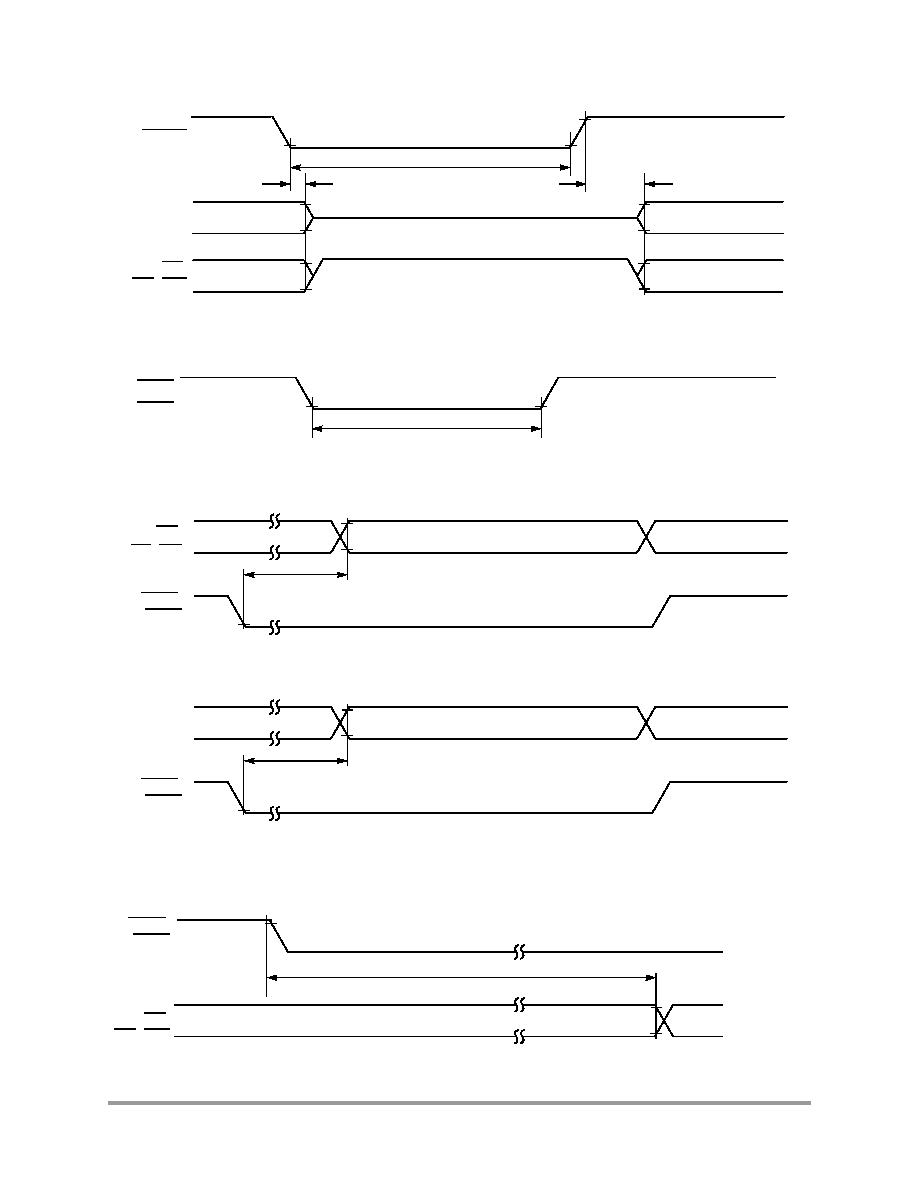
Reset, Stop, Wait, Mode Select, and Interrupt Timing
MOTOROLA
DSP56852 Preliminary Technical Data
23
Figure 12. Asynchronous Reset Timing
Figure 13. External Interrupt Timing (Negative-Edge-Sensitive)
Figure 14. External Level-Sensitive Interrupt Timing
Figure 15. Interrupt from Wait State Timing
First Fetch
A0≠A20,
D0≠D15
CS,
RD, WR
RESET
First Fetch
t
RDA
t
RA
t
RAZ
IRQA
IRQB
t
IRW
A0≠A20,
CS,
RD
,
WR
IRQA,
IRQB
First Interrupt Instruction Execution
a) First Interrupt Instruction Execution
Purpose
I/O Pin
IRQA,
IRQB
b) General Purpose I/O
t
IG
t
IDM
Instruction Fetch
IRQA,
IRQB
First Interrupt Vector
A0≠A20,
CS,
RD, WR
t
IRI
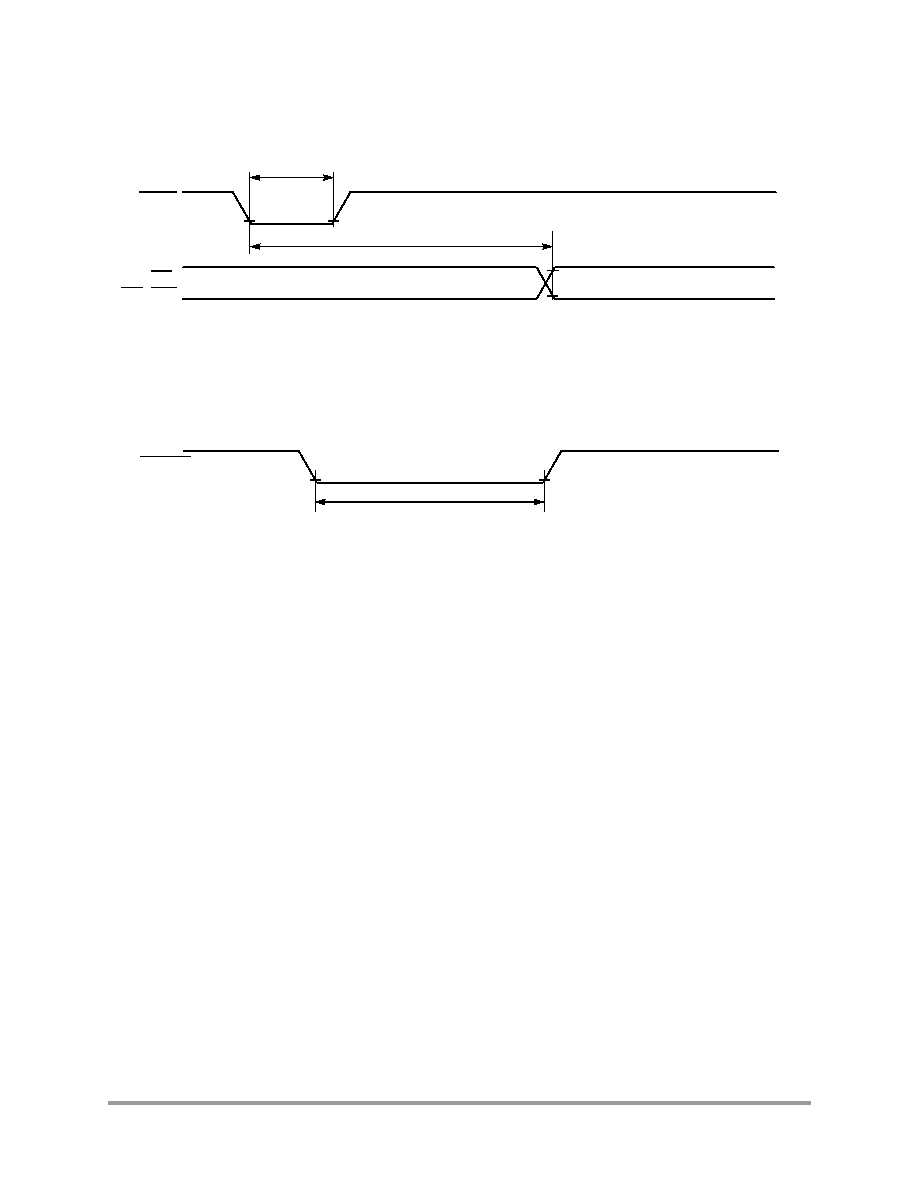
24
DSP56852 Preliminary Technical Data
MOTOROLA
Figure 16. Recovery from Stop State Using Asynchronous Interrupt Timing
Figure 17. Reset Output Timing
Not IRQA Interrupt Vector
IRQA
A0≠A20,
CS,
RD, WR
First Instruction Fetch
t
IW
t
IF
RESET
t
RSTO

Serial Peripheral Interface (SPI) Timing
MOTOROLA
DSP56852 Preliminary Technical Data
25
4.8 Serial Peripheral Interface (SPI) Timing
1.
Parameters listed are guaranteed by design.
Table 12. SPI Timing
1
Operating Conditions: V
SS
= V
SSIO
= V
SSA
= 0V, V
DD
= 1.62-1.98V, V
DDIO
= V
DDA
= 3.0≠3.6V, T
A
= ≠40
∞
to +120
∞
C, C
L
50pF, f
op
= 120MHz
Characteristic
Symbol
Min
Max
Unit
See
Figure
Cycle time
Master
Slave
t
C
25
25
--
--
ns
ns
Figures
18
,
19
,
20
,
21
Enable lead time
Master
Slave
t
ELD
--
12.5
--
--
ns
ns
Figure
21
Enable lag time
Master
Slave
t
ELG
--
12.5
--
--
ns
ns
Figure
21
Clock (SCLK) high time
Master
Slave
t
CH
9
12.5
--
--
ns
ns
Figures
18
,
19
,
20
,
21
Clock (SCLK) low time
Master
Slave
t
CL
12
12.5
--
--
ns
ns
Figure
21
Data setup time required for inputs
Master
Slave
t
DS
10
2
--
--
ns
ns
Figures
18
,
19
,
20
,
21
Data hold time required for inputs
Master
Slave
t
DH
0
2
--
--
ns
ns
Figures
18
,
19
,
20
,
21
Access time (time to data active from high-impedance
state)
Slave
t
A
5
15
ns
ns
Figure
21
Disable time (hold time to high-impedance state)
Slave
t
D
2
9
ns
ns
Figure
21
Data Valid for outputs
Master
Slave (after enable edge)
t
DV
--
--
2
14
ns
ns
Figures
18
,
19
,
20
,
21
Data invalid
Master
Slave
t
DI
0
0
--
--
ns
ns
Figures
18
,
19
,
20
,
21
Rise time
Master
Slave
t
R
--
--
11.5
10.0
ns
ns
Figures
18
,
19
,
20
,
21
Fall time
Master
Slave
t
F
--
--
9.7
9.0
ns
ns
Figures
18
,
19
,
20
,
21
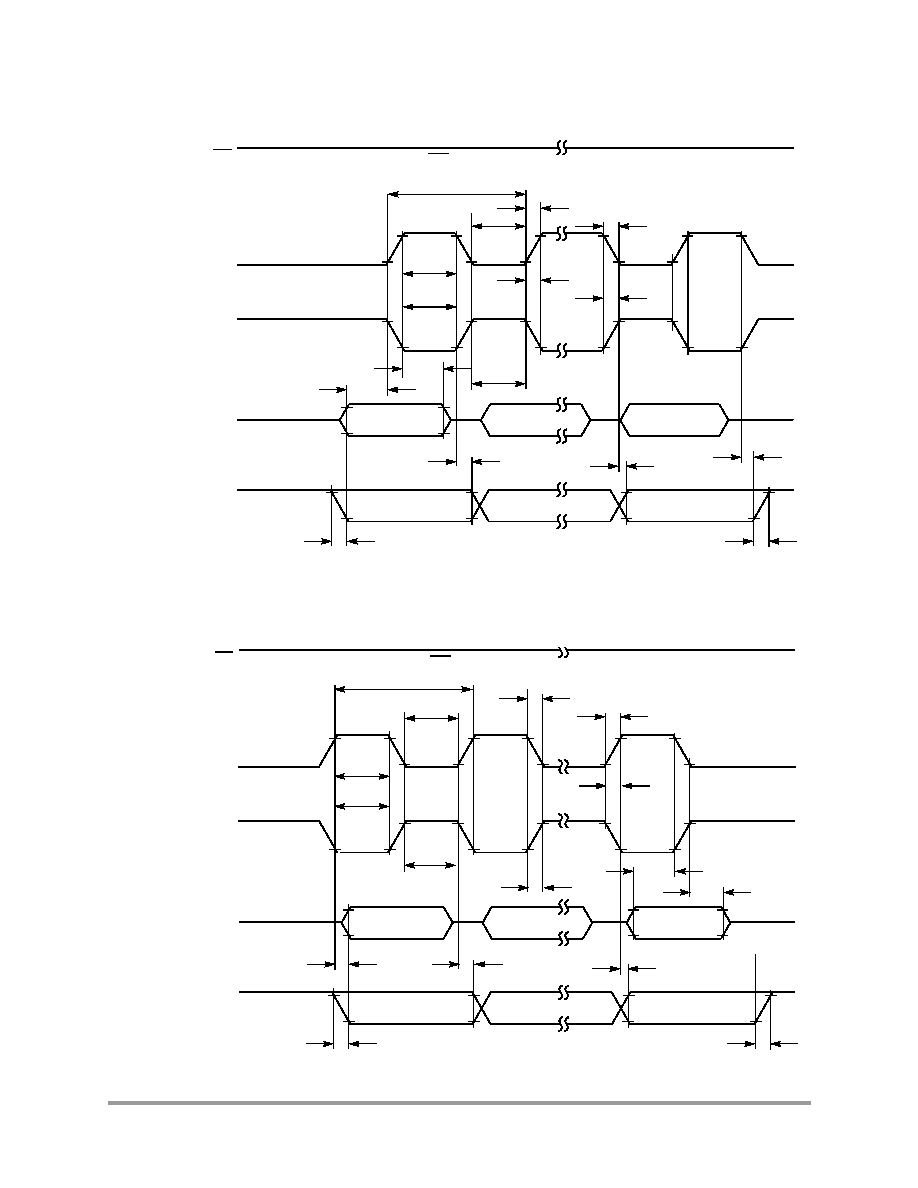
26
DSP56852 Preliminary Technical Data
MOTOROLA
Figure 18. SPI Master Timing (CPHA = 0)
Figure 19. SPI Master Timing (CPHA = 1)
SCLK (CPOL = 0)
(Output)
SCLK (CPOL = 1)
(Output)
MISO
(Input)
MOSI
(Output)
MSB in
Bits 14≠1
LSB in
Master MSB out
Bits 14≠1
Master LSB out
SS
(Input)
SS is held High on master
t
C
t
R
t
F
t
CH
t
CL
t
F
t
R
t
CH
t
CH
t
DV
t
DH
t
DS
t
DI
t
DI
(ref)
t
F
t
R
t
CL
SCLK (CPOL = 0)
(Output)
SCLK (CPOL = 1)
(Output)
MISO
(Input)
MOSI
(Output)
MSB in
Bits 14≠1
LSB in
Master MSB out
Bits 14≠ 1
Master LSB out
SS
(Input)
SS is held High on master
t
R
t
F
t
C
t
CH
t
CL
t
CH
t
CL
t
F
t
DS
t
DH
t
R
t
DI
t
DV
(ref)
t
DV
t
F
t
R
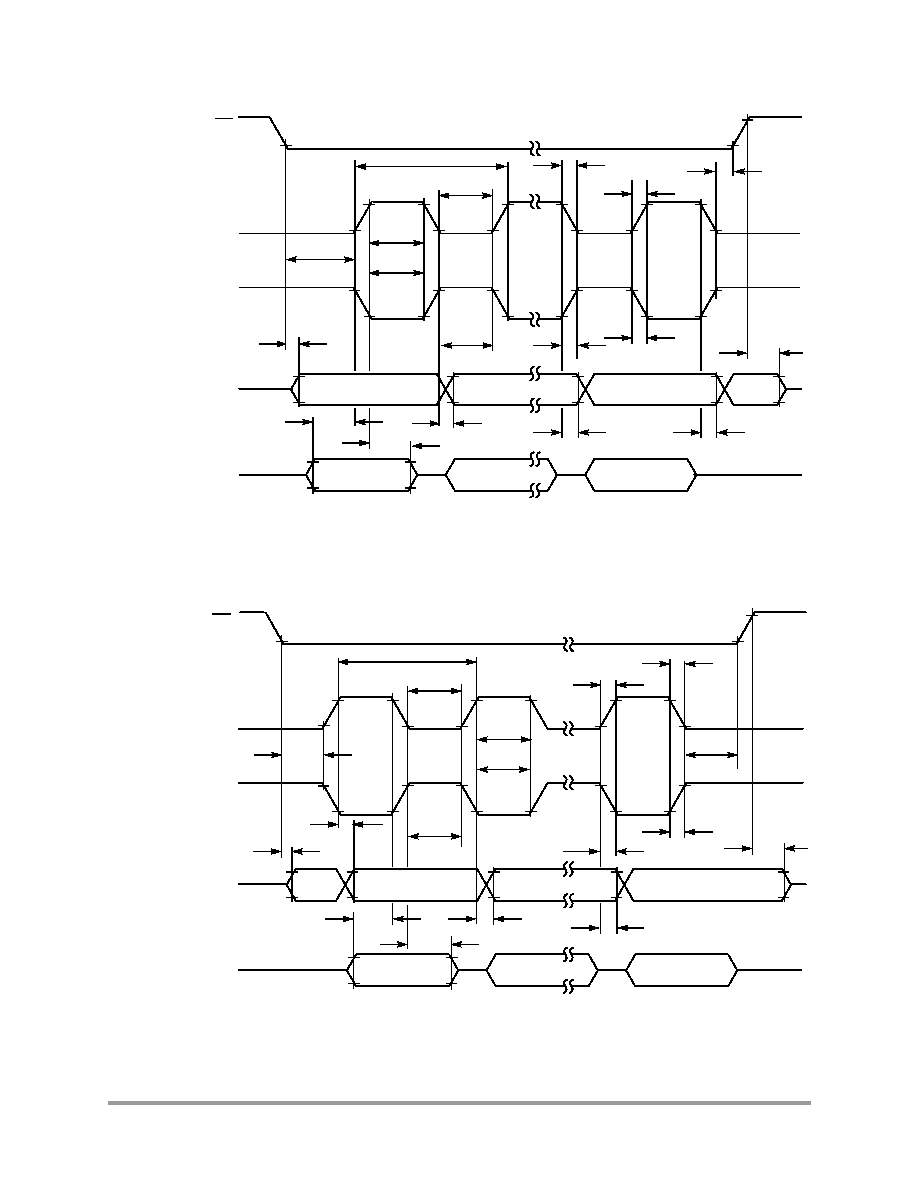
Serial Peripheral Interface (SPI) Timing
MOTOROLA
DSP56852 Preliminary Technical Data
27
Figure 20. SPI Slave Timing (CPHA = 0)
Figure 21. SPI Slave Timing (CPHA = 1)
SCLK (CPOL = 0)
(Input)
SCLK (CPOL = 1)
(Input)
MISO
(Output)
MOSI
(Input)
Slave MSB out
Bits 14≠1
MSB in
Bits 14≠1
LSB in
SS
(Input)
Slave LSB out
t
DS
t
CL
t
CL
t
DI
t
DI
t
CH
t
CH
t
R
t
R
t
ELG
t
DH
t
ELD
t
C
t
F
t
F
t
D
t
A
t
DV
SCLK (CPOL = 0)
(Input)
SCLK (CPOL = 1)
(Input)
MISO
(Output)
MOSI
(Input)
Slave MSB out
Bits 14≠1
MSB in
Bits 14≠1
LSB in
SS
(Input)
Slave LSB out
t
ELG
t
DI
t
DS
t
DH
t
ELD
t
C
t
CL
t
CH
t
R
t
F
t
F
t
CL
t
CH
t
DV
t
A
t
DV
t
R
t
D
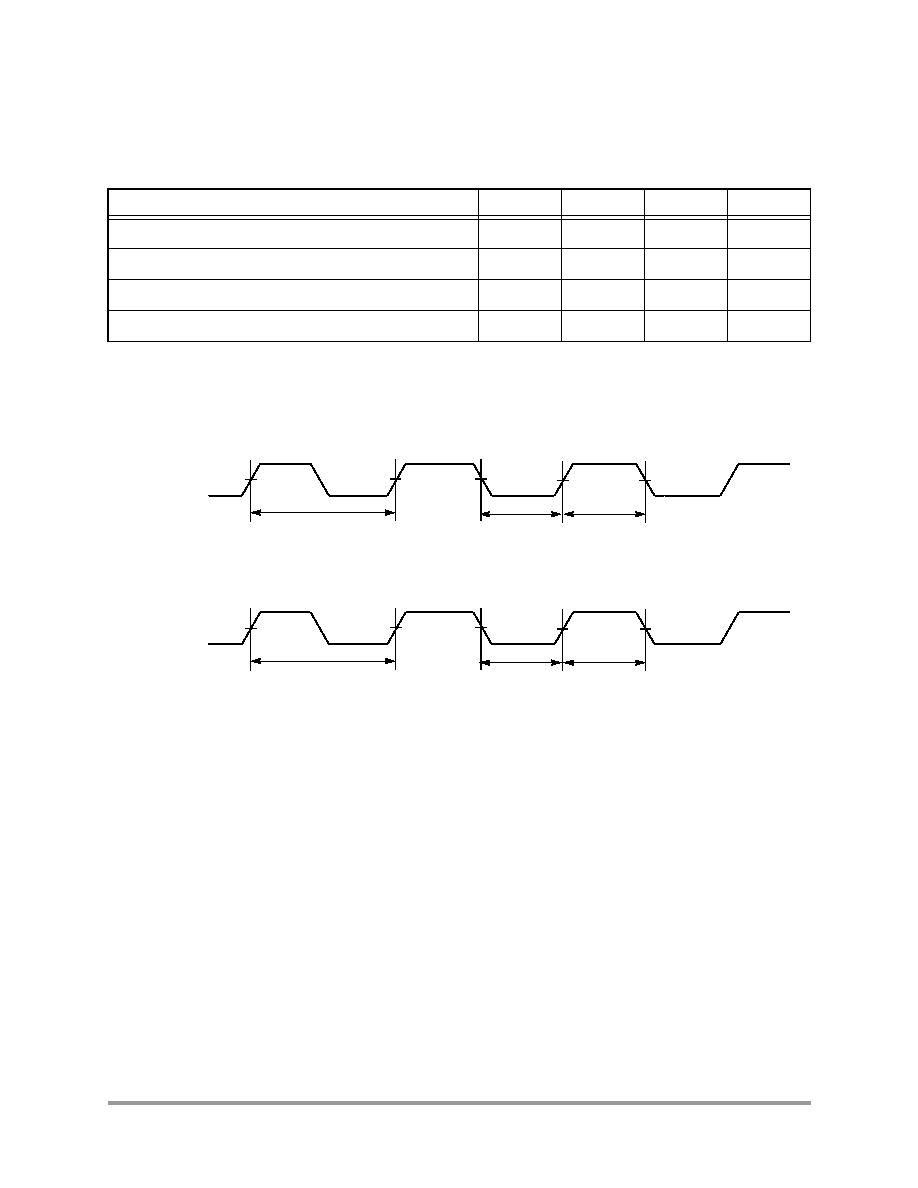
28
DSP56852 Preliminary Technical Data
MOTOROLA
4.9 Quad Timer Timing
Figure 22. Timer Timing
Table 13. Timer Timing
1, 2
Operating Conditions: V
SS
= V
SSIO
= V
SSA
= 0V, V
DD
= 1.62-1.98V, V
DDIO
= V
DDA
= 3.0≠3.6V, T
A
= ≠40
∞
to +120
∞
C, C
L
50pF, f
op
= 120MHz
1.
In the formulas listed, T = clock cycle. For f
op
= 120MHz operation and fipb = 60MHz, T = 8.33ns
2.
Parameters listed are guaranteed by design.
Characteristic
Symbol
Min
Max
Unit
Timer input period
P
IN
2T + 3
--
ns
Timer input high/low period
P
INHL
1T + 3
--
ns
Timer output period
P
OUT
2T - 3
--
ns
Timer output high/low period
P
OUTHL
1T - 3
--
ns
Timer Inputs
Timer Outputs
P
INHL
P
INHL
P
IN
P
OUTHL
P
OUTHL
P
OUT

Synchronous Serial Interface (SSI) Timing
MOTOROLA
DSP56852 Preliminary Technical Data
29
4.10 Synchronous Serial Interface (SSI) Timing
Table 14. SSI Master Mode
1
Switching Characteristics
Operating Conditions: V
SS
= V
SSIO
= V
SSA
= 0V, V
DD
= 1.62-1.98V, V
DDIO
= V
DDA
= 3.0≠3.6V, T
A
= ≠40
∞
to +120
∞
C, C
L
50pF, f
op
= 120MHz
1.
Master mode is internally generated clocks and frame syncs
Parameter
Symbol
Min
Typ
Max
Units
STCK frequency
fs
15
2
2.
Max clock frequency is IP_clk/4 = 60MHz / 4 = 15MHz for a 120MHz part.
MHz
STCK period
3
3.
All the timings for the SSI are given for a non-inverted serial clock polarity (TSCKP=0 in SCR2 and RSCKP=0 in SCSR)
and a non-inverted frame sync (TFSI=0 in SCR2 and RFSI=0 in SCSR). If the polarity of the clock and/or the frame sync has
been inverted, all the timings remain valid by inverting the clock signal STCK/SRCK and/or the frame sync STFS/SRFS in
the tables and in the figures.
t
SCKW
66.7
ns
STCK high time
t
SCKH
33.4
ns
STCK low time
t
SCKL
33.4
ns
Output clock rise/fall time
4
ns
Delay from STCK high to STFS (bl) high - Master
4
4.
bl = bit length; wl = word length
t
TFSBHM
-1.0
-0.1
ns
Delay from STCK high to STFS (wl) high - Master
4
t
TFSWHM
-1.0
-0.1
ns
Delay from SRCK high to SRFS (bl) high - Master
4
t
RFSBHM
0.1
1.0
ns
Delay from SRCK high to SRFS (wl) high - Master
4
t
RFSWHM
0.1
1.0
ns
Delay from STCK high to STFS (bl) low - Master
4
t
TFSBLM
-1.0
-0.1
ns
Delay from STCK high to STFS (wl) low - Master
4
t
TFSWLM
-1.0
-0.1
ns
Delay from SRCK high to SRFS (bl) low - Master
4
t
RFSBLM
-0.1
0.1
ns
Delay from SRCK high to SRFS (wl) low - Master
4
t
RFSWLM
-0.1
0.1
ns
STCK high to STXD enable from high impedance - Master
t
TXEM
0
1
ns
STCK high to STXD valid - Master
t
TXVM
0
1
ns
STCK high to STXD not valid - Master
t
TXNVM
-0.1
0
ns
STCK high to STXD high impedance - Master
t
TXHIM
-4
0
ns
SRXD Setup time before SRCK low - Master
t
SM
4
ns
SRXD Hold time after SRCK low - Master
t
HM
4
ns
Synchronous Operation (in addition to standard internal clock parameters)
SRXD Setup time before STCK low - Master
t
TSM
4
SRXD Hold time after STCK low - Master
t
THM
4

30
DSP56852 Preliminary Technical Data
MOTOROLA
Figure 23. Master Mode Timing Diagram
Table 15. SSI Slave Mode
1
Switching Characteristics
Operating Conditions: V
SS
= V
SSIO
= V
SSA
= 0V, V
DD
= 1.62-1.98V, V
DDIO
= V
DDA
= 3.0≠3.6V, T
A
= ≠40
∞
to +120
∞
C, C
L
50pF, f
op
= 120MHz
Parameter
Symbol
Min
Typ
Max
Units
STCK frequency
fs
15
2
MHz
STCK period
3
t
SCKW
66.7
ns
STCK high time
t
SCKH
33.4
4
ns
STCK low time
t
SCKL
33.4
4
ns
Output clock rise/fall time
4
ns
Delay from STCK high to STFS (bl) high - Slave
5
t
TFSBHS
-1
29
ns
Delay from STCK high to STFS (wl) high - Slave
5
t
TFSWHS
-1
29
ns
t
THM
t
TSM
t
HM
t
SM
t
RFSWLM
t
RFSWHM
t
RFBLM
t
RFSBHM
t
TXHIM
t
TXNVM
t
TXVM
t
TXEM
t
TFSWLM
t
TFSWHM
t
TFSBLM
t
TFSBHM
t
SCKL
t
SCKW
t
SCKH
First Bit
Last Bit
STCK output
STFS (bl) output
STFS (wl) output
STXD
SRCK output
SRFS (bl) output
SRFS (wl) output
SRXD

Synchronous Serial Interface (SSI) Timing
MOTOROLA
DSP56852 Preliminary Technical Data
31
Delay from SRCK high to SRFS (bl) high - Slave
5
t
RFSBHS
-1
29
ns
Delay from SRCK high to SRFS (wl) high - Slave
5
t
RFSWHS
-1
29
ns
Delay from STCK high to STFS (bl) low - Slave
5
t
TFSBLS
-29
29
ns
Delay from STCK high to STFS (wl) low - Slave
5
t
TFSWLS
-29
29
ns
Delay from SRCK high to SRFS (bl) low - Slave
5
t
RFSBLS
-29
29
ns
Delay from SRCK high to SRFS (wl) low - Slave
5
t
RFSWLS
-29
29
ns
STCK high to STXD enable from high impedance - Slave
t
TXES
--
15
ns
STCK high to STXD valid - Slave
t
TXVS
4
15
ns
STFS high to STXD enable from high impedance (first bit) -
Slave
t
FTXES
4
15
ns
STFS high to STXD valid (first bit) - Slave
t
FTXVS
4
15
ns
STCK high to STXD not valid - Slave
t
TXNVS
4
15
ns
STCK high to STXD high impedance - Slave
t
TXHIS
4
15
ns
SRXD Setup time before SRCK low - Slave
t
SS
4
--
ns
SRXD Hold time after SRCK low - Slave
t
HS
4
--
ns
Synchronous Operation (in addition to standard external clock parameters)
SRXD Setup time before STCK low - Slave
t
TSS
4
--
?
SRXD Hold time after STCK low - Slave
t
THS
4
--
?
1.
Slave mode is externally generated clocks and frame syncs
2.
Max clock frequency is IP_clk/4 = 60MHz / 4 = 15MHz for a 120MHz part.
3.
All the timings for the SSI are given for a non-inverted serial clock polarity (TSCKP=0 in SCR2 and RSCKP=0 in SCSR)
and a non-inverted frame sync (TFSI=0 in SCR2 and RFSI=0 in SCSR). If the polarity of the clock and/or the frame sync
has been inverted, all the timings remain valid by inverting the clock signal STCK/SRCK and/or the frame sync STFS/SRFS
in the tables and in the figures.
4.
50 percent duty cycle
5.
bl = bit length; wl = word length
Table 15. SSI Slave Mode
1
Switching Characteristics (Continued)
Operating Conditions: V
SS
= V
SSIO
= V
SSA
= 0V, V
DD
= 1.62-1.98V, V
DDIO
= V
DDA
= 3.0≠3.6V, T
A
= ≠40
∞
to +120
∞
C, C
L
50pF, f
op
= 120MHz
Parameter
Symbol
Min
Typ
Max
Units
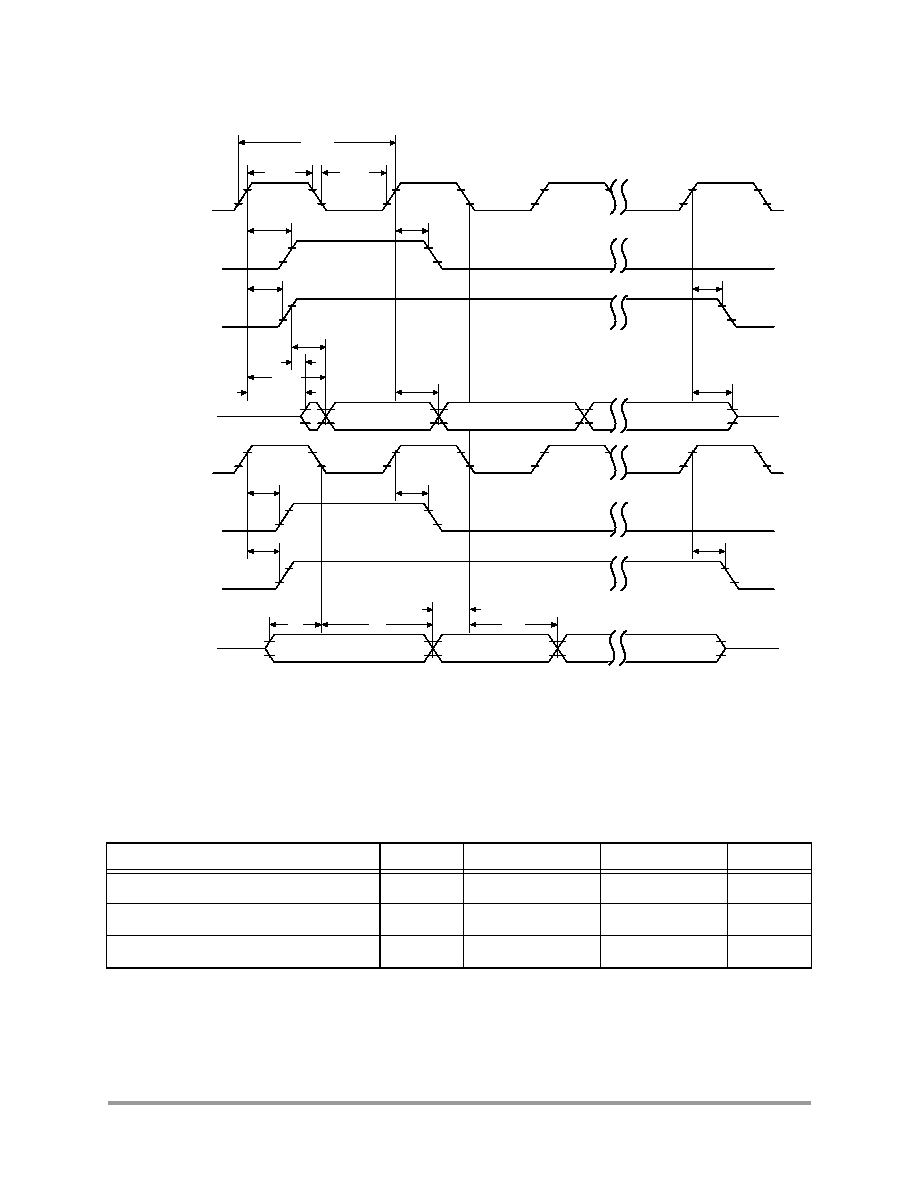
32
DSP56852 Preliminary Technical Data
MOTOROLA
Figure 24. Slave Mode Clock Timing
4.11 Serial Communication Interface (SCI) Timing
Table 16. SCI Timing
4
Operating Conditions: V
SS
= V
SSIO
= V
SSA
= 0V, V
DD
= 1.62-1.98V, V
DDIO
= V
DDA
= 3.0≠3.6V, T
A
= ≠40
∞
to +120
∞
C, C
L
50pF, f
op
= 120MHz
Characteristic
Symbol
Min
Max
Unit
Baud Rate
1
1.
f
MAX
is the frequency of operation of the system clock in MHz.
BR
--
(f
MAX
)/(32)
Mbps
RXD
2
Pulse Width
2.
The RXD pin in SCI0 is named RXD0 and the RXD pin in SCI1 is named RXD1.
RXD
PW
0.965/BR
1.04/BR
ns
TXD
3
Pulse Width
3.
The TXD pin in SCI0 is named TXD0 and the TXD pin in SCI1 is named TXD1.
4.
Parameters listed are guaranteed by design.
TXD
PW
0.965/BR
1.04/BR
ns
t
THS
t
TSS
t
HS
t
SS
t
RFSWLS
t
RFSWHS
t
RFSBLS
t
RFSBHS
t
TXHIS
t
TXNVS
t
FTXVS
t
TXVS
t
FTXES
t
TXES
t
TFSWLS
t
TFSWHS
t
TFSBLS
t
TFSBHS
t
SCKL
t
SCKW
t
SCKH
First Bit
Last Bit
STCK input
STFS (bl) input
STFS (wl) input
STXD
SRCK input
SRFS (bl) input
SRFS (wl) input
SRXD
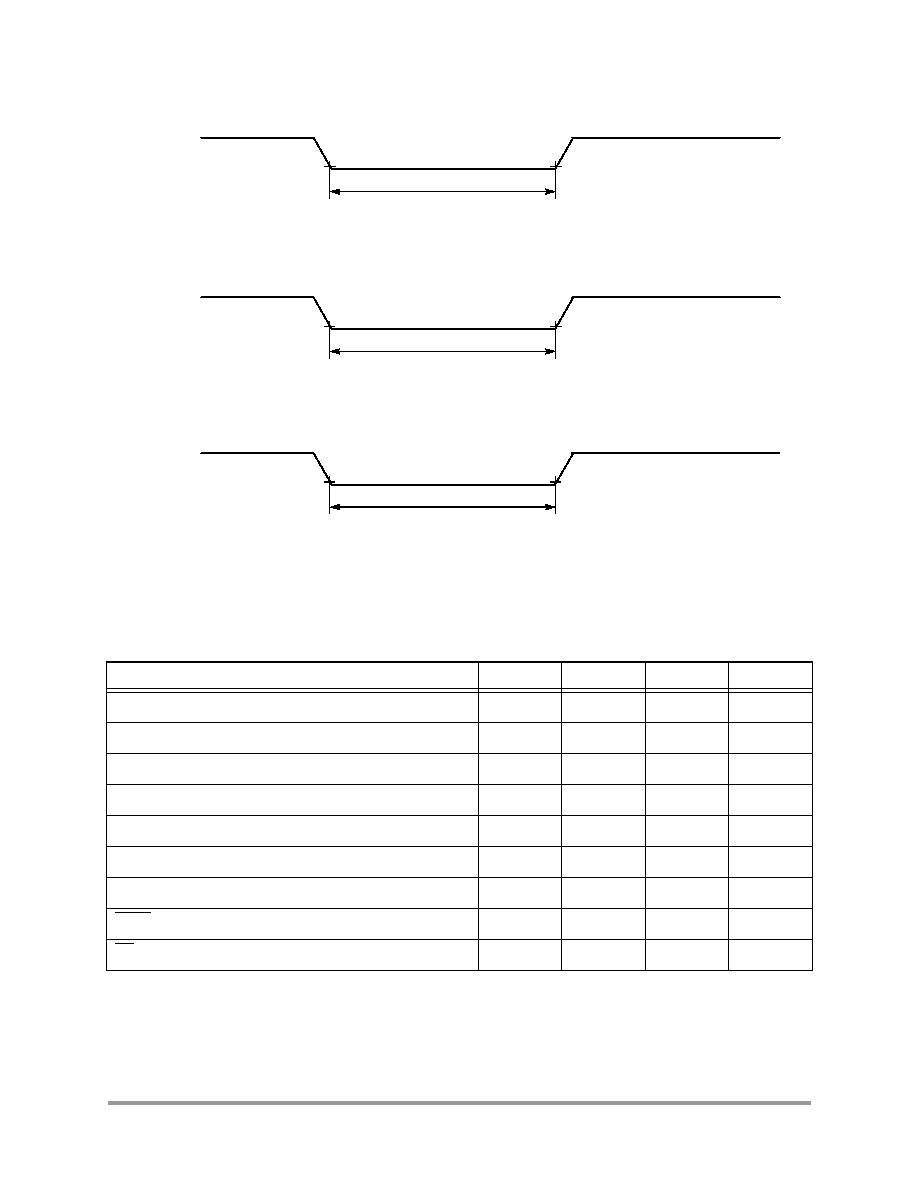
JTAG Timing
MOTOROLA
DSP56852 Preliminary Technical Data
33
Figure 25. RXD Pulse Width
Figure 26. TXD Pulse Width
Figure 27. Bus Wakeup Detection
4.12 JTAG Timing
Table 17. JTAG Timing
1, 3
Operating Conditions: V
SS
= V
SSIO
= V
SSA
= 0V, V
DD
= 1.62-1.98V, V
DDIO
= V
DDA
= 3.0≠3.6V, T
A
= ≠40
∞
to +120
∞
C, C
L
50pF, f
op
= 120MHz
1.
Timing is both wait state and frequency dependent. For the values listed, T = clock cycle. For120MHz
operation, T = 8.33 ns
Characteristic
Symbol
Min
Max
Unit
TCK frequency of operation
2
2.
TCK frequency of operation must be less than 1/4 the processor rate.
3.
Parameters listed are guaranteed by design.
f
OP
DC
30
MHz
TCK cycle time
t
CY
33.3
--
ns
TCK clock pulse width
t
PW
16.6
--
ns
TMS, TDI data setup time
t
DS
3
--
ns
TMS, TDI data hold time
t
DH
3
--
ns
TCK low to TDO data valid
t
DV
--
12
ns
TCK low to TDO tri-state
t
TS
--
10
ns
TRST assertion time
t
TRST
35
--
ns
DE assertion time
t
DE
4T
--
ns
RXD
SCI receive
data pin
(Input)
RXD
PW
TXD
SCI receive
data pin
(Input)
TXD
PW
MSCAN_RX
CAN receive
data pin
(Input)
T
WAKE-UP
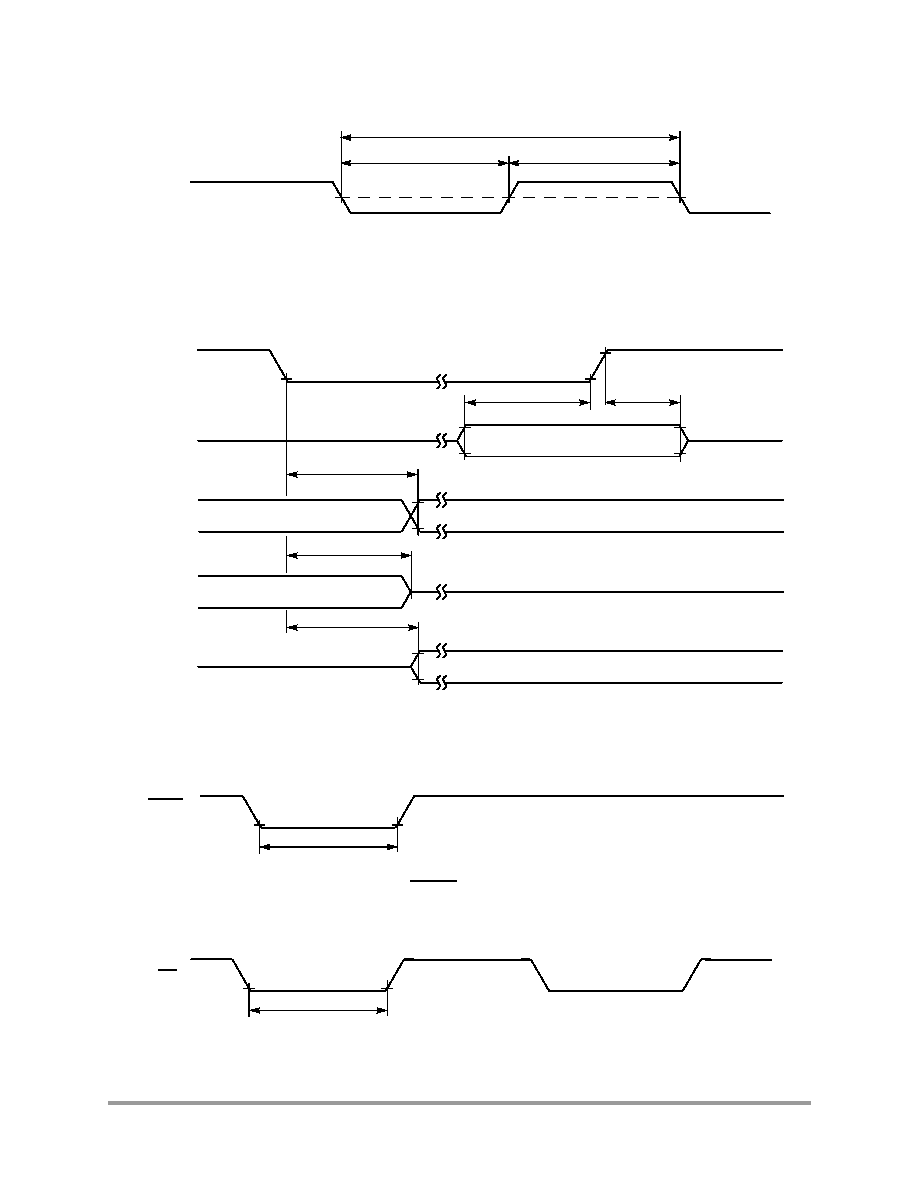
34
DSP56852 Preliminary Technical Data
MOTOROLA
Figure 28. Test Clock Input Timing Diagram
Figure 29. Test Access Port Timing Diagram
Figure 30. TRST Timing Diagram
Figure 31. Enhanced OnCE--Debug Event
TCK
(Input)
V
M
V
IL
V
M
= V
IL
+ (V
IH
≠ V
IL
)/2
V
M
V
IH
t
PW
t
PW
t
CY
Input Data Valid
Output Data Valid
Output Data Valid
TCK
(Input)
TDI
(Input)
TDO
(Output)
TDO
(Output
)
TDO
(Output)
TMS
t
DV
t
TS
t
DV
t
DS
t
DH
TRST
(Input)
t
TRST
DE
t
DE
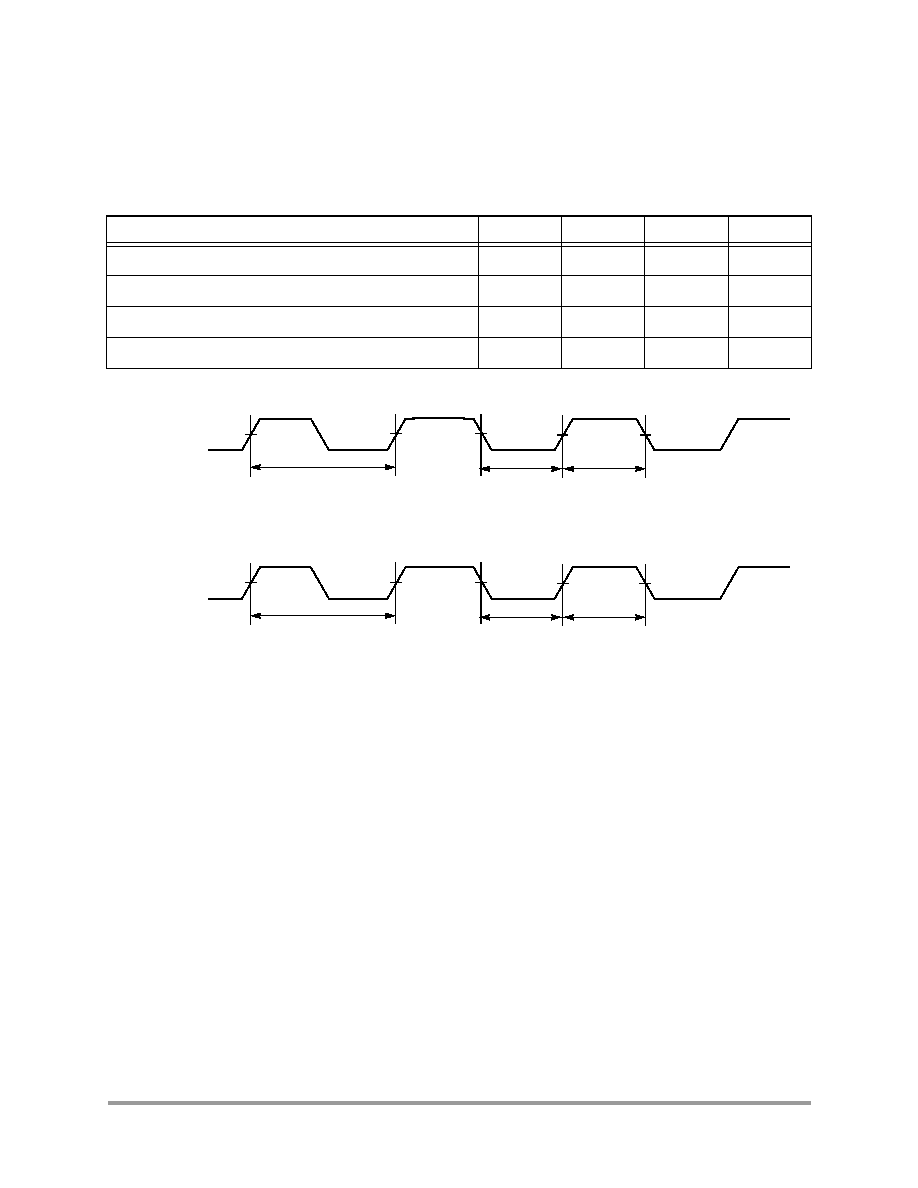
GPIO Timing
MOTOROLA
DSP56852 Preliminary Technical Data
35
4.13 GPIO Timing
Figure 32. GPIO Timing
Table 18. GPIO Timing
Operating Conditions: V
SS
= V
SSIO
= V
SSA
= 0V, V
DD
= 1.7-1.9V, V
DDIO
= V
DDA
= 3.0≠3.6V, T
A
= ≠40
∞
to +120
∞
C, C
L
50pF, f
op
= 120MHz
Characteristic
Symbol
Min
Max
Unit
GPIO input period
P
IN
2T + 3
--
ns
GPIO input high/low period
P
INHL
1T + 3
--
ns
GPIO output period
P
OUT
2T - 3
--
ns
GPIO output high/low period
P
OUTHL
1T - 3
--
ns
GPIO Inputs
GPIO Outputs
P
INHL
P
INHL
P
IN
P
OUTHL
P
OUTHL
P
OUT
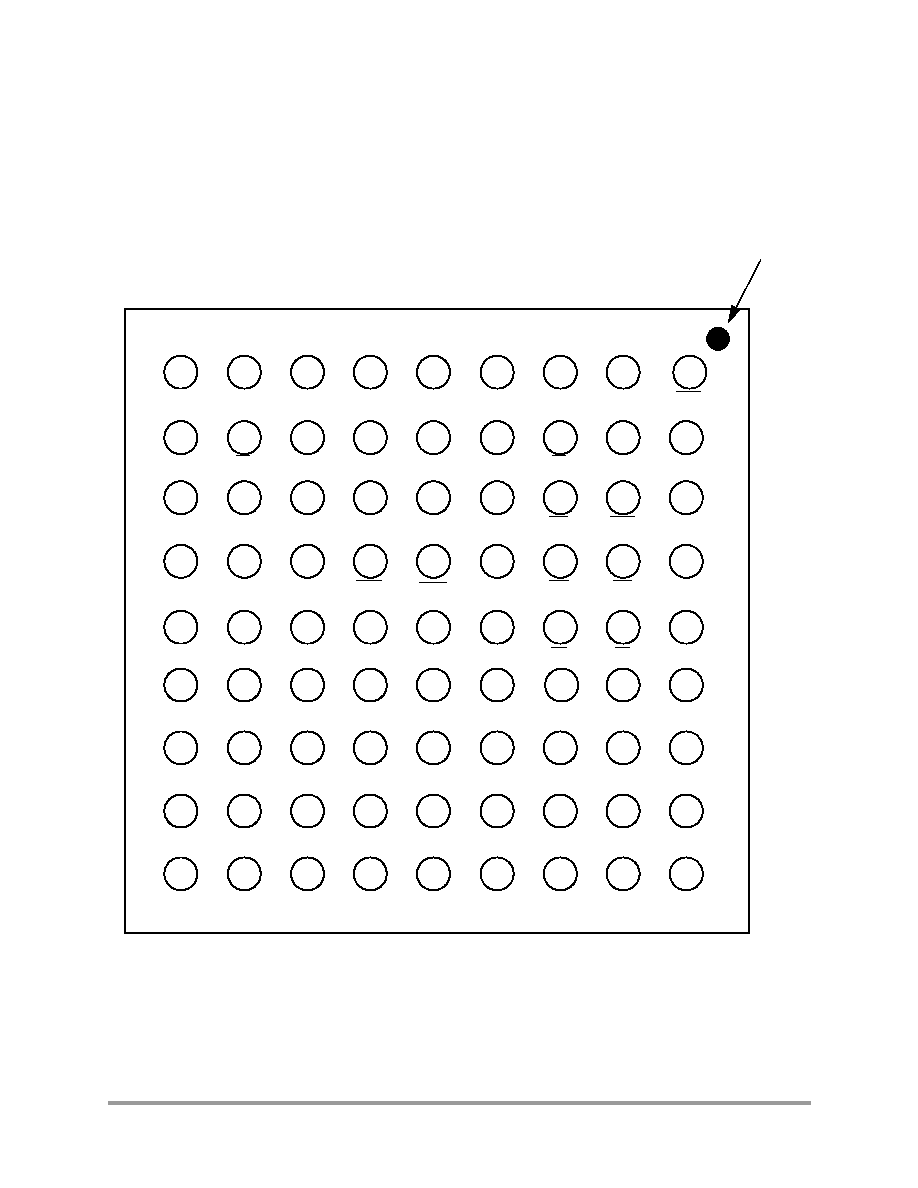
36
DSP56852 Preliminary Technical Data
MOTOROLA
Part 5 DSP56852 Packaging & Pinout Information
This section contains package and pin-out information for the 81-pin MAPBGA configuration of the
DSP56852.
Figure 33. Bottom-View, DSP56852 81-pin MAPBGA Package
METALLIZED MARK FOR
PIN 1 IDENTIFICATION
IN THIS AREA
A
B
C
D
E
F
G
H
J
1
2
3
4
5
6
7
8
9
IRQA
GPIOC1
SCK
V
DDIO
V
SSIO
TD0
EXTAL
V
DDA
TDI
GPIOC0
SS
RXD
IRQB
V
DDIO
V
SSIO
TXD
V
SS
CS0
MOSI
MISO
CS1
D14
TMS
TCK
D15
DE
V
SSA
V
DDIO
V
SSIO
CS2
RESET
RD
V
DD
D13
D12
TRST
D8
V
DD
D11
D10
D9
A16
V
SS
D6
A0
WR
A1
V
SSIO
D3
V
DDIO
D5
A17
D0
D7
A18
A12
A14
A3
A6
A5
A15
A8
A7
V
DDIO
A11
A9
D2
A19
D1
D4
V
SSIO
CLKO
V
DDIO
V
SSIO
V
DD
V
SS
A13
A10
XTAL
A4
A2
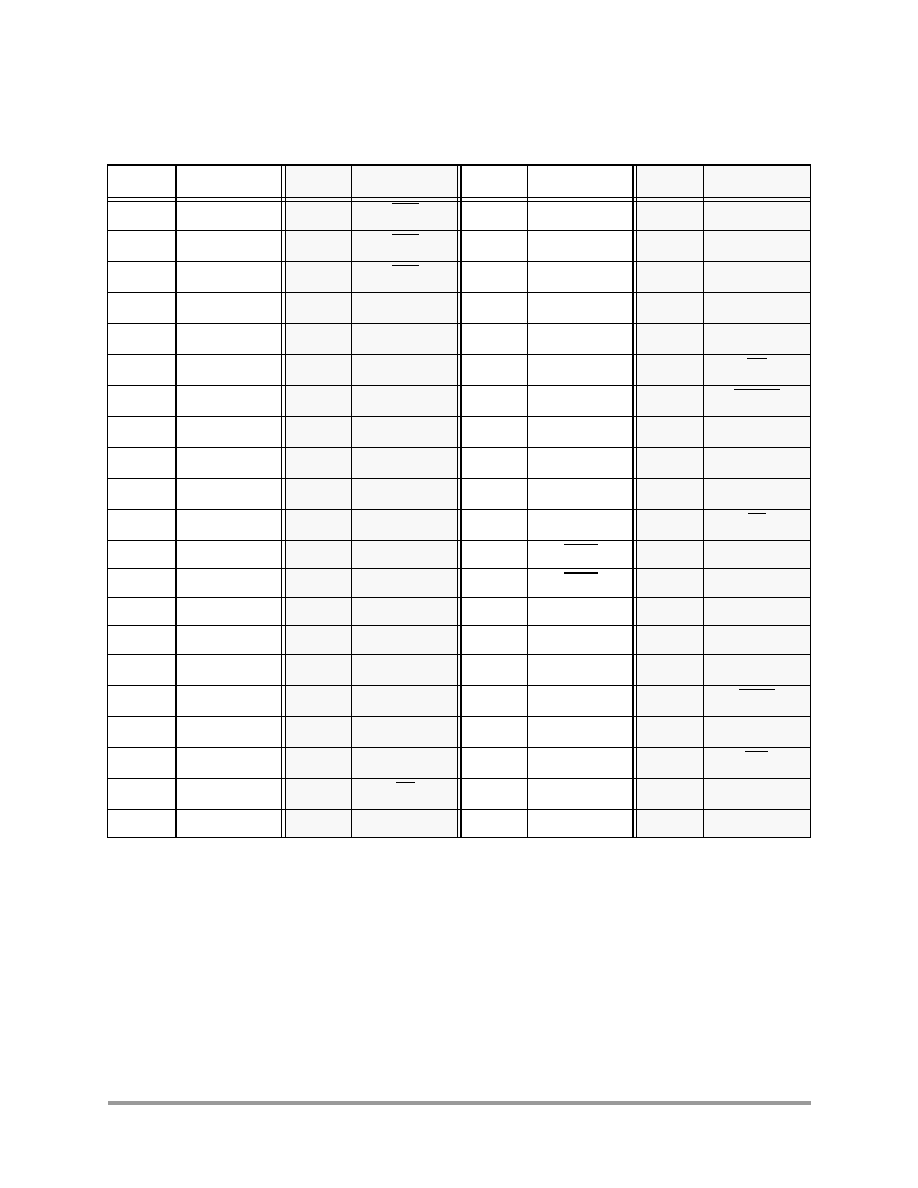
GPIO Timing
MOTOROLA
DSP56852 Preliminary Technical Data
37
Table 19. DSP56852 Pin Identification by Pin Number
Pin No.
Signal Name
Pin No.
Signal Name
Pin No.
Signal Name
Pin No.
Signal Name
E4
A0
D2
CS0
A6
EXTAL
H1
V
DDIO
F2
A1
D3
CS1
B6
V
SSA
J7
V
DDIO
F3
A2
C3
CS2
D1
V
SS
G9
V
DDIO
F4
A3
G7
D0
J4
V
SS
B9
V
DDIO
F1
A4
H7
D1
F9
V
SS
A4
V
DDIO
G3
A5
H8
D2
B1
V
SSIO
E2
RD
G2
A6
G8
D3
G1
V
SSIO
D5
RESET
J1
A7
H9
D4
J6
V
SSIO
B4
RXD
H2
A8
F8
D5
J9
V
SSIO
A3
SCK
H3
A9
F7
D6
C9
V
SSIO
A2
GPIOC1
J2
A10
G6
D7
A5
V
SSIO
B3
SS
H4
A11
E8
D8
A1
IRQA
B2
GPIOC0
G4
A12
E7
D9
C2
IRQB
C6
TCK
J3
A13
E6
D10
C4
MISO
B7
TDI
F5
A14
D8
D11
C5
MOSI
A8
TDO
H5
A15
D7
D12
B5
V
DDA
C7
TMS
E5
A16
D9
D13
E1
V
DD
D6
TRST
F6
A17
C8
D14
J5
V
DD
D4
TXD
G5
A18
A9
D15
E9
V
DD
E3
WR
H6
A19
B8
DE
C1
V
DDIO
A7
XTAL
J8
CLKO
-
-
-
-
-
-
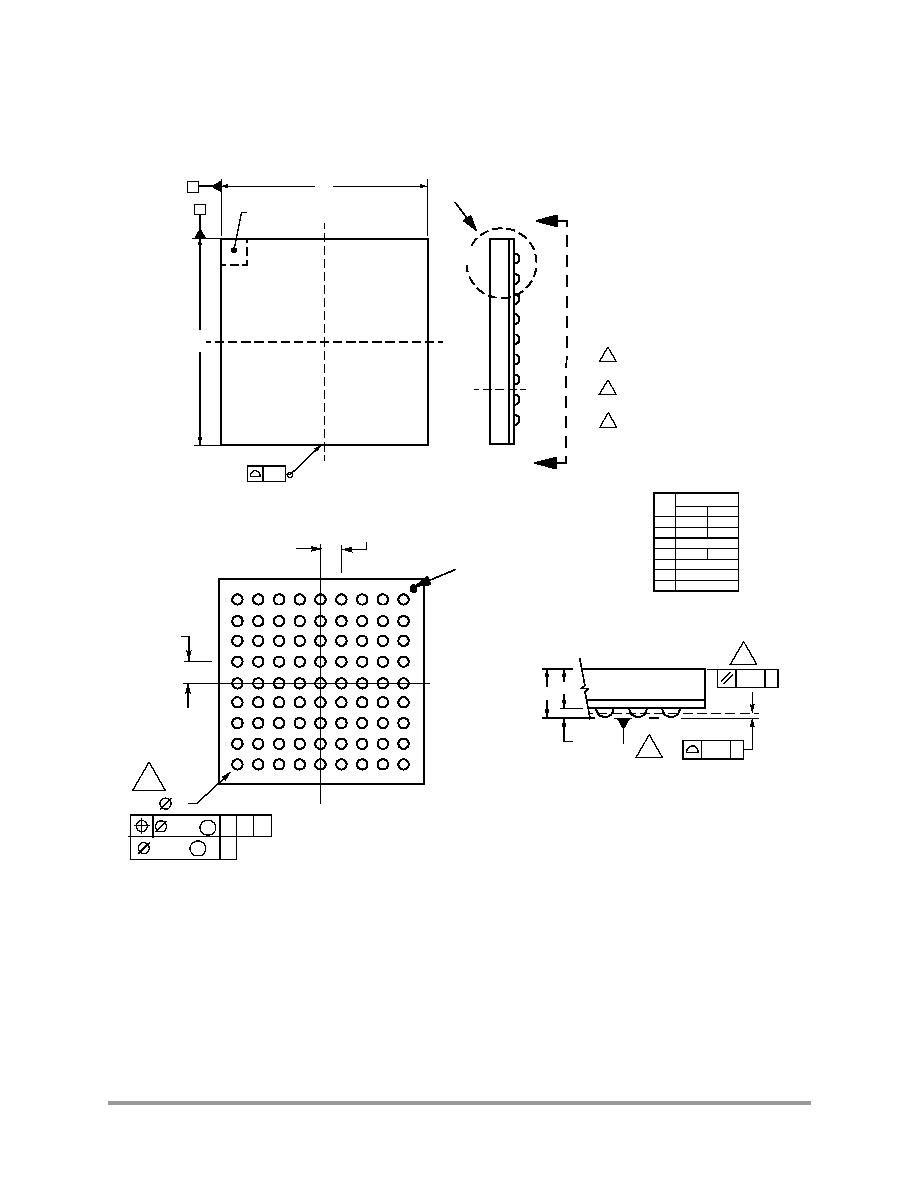
38
DSP56852 Preliminary Technical Data
MOTOROLA
Figure 34. 81-pin MAPBGA Mechanical Information
NOTES:
1.
DIMENSIONS ARE IN MILLIMETERS.
2.
INTERPRET DIMENSIONS AND
TOLERANCES PER ASME Y14.5M, 1994.
3.
DIMENSION b IS MEASURED AT THE
MAXIMUM SOLDER BALL DIAMETER,
PARALLEL TO DATUM PLANE Z.
4.
DATUM Z (SEATING PLANE) IS DEFINED BY
THE SPHERICAL CROWNS OF THE SOLDER
BALLS.
5.
PARALLELISM MEASUREMENT SHALL
EXCLUDE ANY EFFECT OF MARK ON TOP
SURFACE OF PACKAGE.
CASE 1224B-01
ISSUE A
DATE 06/30/00
X
0.20
LASER MARK FOR PIN 1
IDENTIFICATION IN
THIS AREA
D
E
M
A1
A2
A
0.15 Z
0.30 Z
Z
ROTATED 90 CLOCKWISE
DETAIL K
∞
5
VIEW M-M
e
8X
X
0.25
Y
Z
0.10
Z
3
b
81X
4
160X
DIM MIN
MAX
MILLIMETERS
A
0.95
1.3
A1
0.2
0.34
A2
0.96 REF
b
0.3
0.5
D
8.00 BSC
E
8.00 BSC
e
0.80 BSC
Y
Detail K
METALIZED MARK FOR
PIN 1 IDENTIFICATION
IN THIS AREA
A
B
C
D
E
F
G
H
J
1
2
3
6
7
8
9
e
8X
M
M

Thermal Design Considerations
MOTOROLA
DSP56852 Preliminary Technical Data
39
Part 6 Design Considerations
6.1 Thermal Design Considerations
An estimation of the chip junction temperature, T
J
, in
∞C can be obtained from the equation:
Equation 1:
T
J
= T
A
+ (P
D
x R
JA
)
Where:
T
A
= ambient temperature ∞C
R
JA
= package junction-to-ambient thermal resistance ∞C/W
P
D
= power dissipation in package
Historically, thermal resistance has been expressed as the sum of a junction-to-case thermal resistance and
a case-to-ambient thermal resistance:
Equation 2:
R
JA
= R
JC
+ R
CA
Where:
R
JA
= package junction-to-ambient thermal resistance ∞C/W
R
JC
= package junction-to-case thermal resistance ∞C/W
R
CA
= package case-to-ambient thermal resistance ∞C/W
R
JC
is device-related and cannot be influenced by the user. The user controls the thermal environment to
change the case-to-ambient thermal resistance, R
CA
. For example, the user can change the air flow around
the device, add a heat sink, change the mounting arrangement on the Printed Circuit Board (PCB), or
otherwise change the thermal dissipation capability of the area surrounding the device on the PCB. This
model is most useful for ceramic packages with heat sinks; some 90% of the heat flow is dissipated through
the case to the heat sink and out to the ambient environment. For ceramic packages, in situations where the
heat flow is split between a path to the case and an alternate path through the PCB, analysis of the device
thermal performance may need the additional modeling capability of a system level thermal simulation tool.
The thermal performance of plastic packages is more dependent on the temperature of the PCB to which the
package is mounted. Again, if the estimations obtained from R
JA
do not satisfactorily answer whether the
thermal performance is adequate, a system level model may be appropriate.
A complicating factor is the existence of three common definitions for determining the junction-to-case
thermal resistance in plastic packages:
∑
Measure the thermal resistance from the junction to the outside surface of the package (case) closest
to the chip mounting area when that surface has a proper heat sink. This is done to minimize
temperature variation across the surface.
∑
Measure the thermal resistance from the junction to where the leads are attached to the case. This
definition is approximately equal to a junction to board thermal resistance.
∑
Use the value obtained by the equation (T
J
≠ T
T
)/P
D
where T
T
is the temperature of the package
case determined by a thermocouple.
As noted above, the junction-to-case thermal resistances quoted in this data sheet are determined using the
first definition. From a practical standpoint, that value is also suitable for determining the junction
temperature from a case thermocouple reading in forced convection environments. In natural convection,
using the junction-to-case thermal resistance to estimate junction temperature from a thermocouple reading

40
DSP56852 Preliminary Technical Data
MOTOROLA
on the case of the package will estimate a junction temperature slightly hotter than actual. Hence, the new
thermal metric, Thermal Characterization Parameter, or
JT
, has been defined to be (T
J
≠ T
T
)/P
D
. This value
gives a better estimate of the junction temperature in natural convection when using the surface temperature
of the package. Remember that surface temperature readings of packages are subject to significant errors
caused by inadequate attachment of the sensor to the surface and to errors caused by heat loss to the sensor.
The recommended technique is to attach a 40-gauge thermocouple wire and bead to the top center of the
package with thermally conductive epoxy.
6.2 Electrical Design Considerations
Use the following list of considerations to assure correct DSP operation:
∑
Provide a low-impedance path from the board power supply to each V
DD
pin on the DSP, and from
the board ground to each V
SS
(GND) pin.
∑
The minimum bypass requirement is to place six 0.01≠0.1
µF capacitors positioned as close as
possible to the package supply pins. The recommended bypass configuration is to place one bypass
capacitor on each of the ten V
DD
/V
SS
pairs, including V
DDA
/V
SSA.
∑
Ensure that capacitor leads and associated printed circuit traces that connect to the chip V
DD
and
V
SS
(GND) pins are less than 0.5 inch per capacitor lead.
∑
Use at least a four-layer Printed Circuit Board (PCB) with two inner layers for V
DD
and GND.
∑
Bypass the V
DD
and GND layers of the PCB with approximately 100
µF, preferably with a high-
grade capacitor such as a tantalum capacitor.
∑
Because the DSP output signals have fast rise and fall times, PCB trace lengths should be minimal.
∑
Consider all device loads as well as parasitic capacitance due to PCB traces when calculating
capacitance. This is especially critical in systems with higher capacitive loads that could create
higher transient currents in the V
DD
and GND circuits.
∑
All inputs must be terminated (i.e., not allowed to float) using CMOS levels.
∑
Take special care to minimize noise levels on the V
DDA
and V
SSA
pins.
∑
When using Wired-OR mode on the SPI or the IRQx pins, the user must provide an external pull-
up device.
CAUTION
This device contains protective circuitry to guard against
damage due to high static voltage or electrical fields.
However, normal precautions are advised to avoid
application of any voltages higher than maximum rated
voltages to this high-impedance circuit. Reliability of
operation is enhanced if unused inputs are tied to an
appropriate voltage level.

Electrical Design Considerations
MOTOROLA
DSP56852 Preliminary Technical Data
41
∑
Designs that utilize the TRST pin for JTAG port or Enhance OnCE module functionality (such as
development or debugging systems) should allow a means to assert TRST whenever RESET is
asserted, as well as a means to assert TRST independently of RESET. Designs that do not require
debugging functionality, such as consumer products, should tie these pins together.
∑
The internal POR (Power on Reset) will reset the part at power on with reset asserted or pulled high
but requires that TRST be asserted at power on.

42
DSP56852 Preliminary Technical Data
MOTOROLA
Part 7 Ordering Information
Table 20
lists the pertinent information needed to place an order. Consult a Motorola Semiconductor sales
office or authorized distributor to determine availability and to order parts.
Table 20. DSP56852 Ordering Information
Part
Supply
Voltage
Package Type
Pin
Count
Frequency
(MHz)
Order Number
DSP56852
1.8≠3.3 V
Mold Array Process Ball Grid Array
(MAPBGA)
81
120
DSP56852VF120

Electrical Design Considerations
MOTOROLA
DSP56852 Preliminary Technical Data
43

DSP56852/D
MOTOROLA and the Stylized M Logo are registered in the US Patent & Trademark Office. All other product or service names are the property of their
respective owners. © Motorola, Inc. 2003.
How to reach us:
USA/EUROPE/Locations Not Listed: Motorola Literature Distribution; P.O. Box 5405, Denver, Colorado 80217. 1≠303≠675≠2140 or 1≠800≠441≠2447
JAPAN: Motorola Japan Ltd.; SPS, Technical Information Center, 3≠20≠1, Minami≠Azabu. Minato≠ku, Tokyo 106≠8573 Japan. 81≠3≠3440≠3569
ASIA/PACIFIC: Motorola Semiconductors H.K. Ltd.; Silicon Harbour Centre, 2 Dai King Street, Tai Po Industrial Estate, Tai Po, N.T., Hong Kong. 852≠26668334
Technical Information Center: 1≠800≠521≠6274
HOME PAGE: http://www.motorola.com/semiconductors/
Motorola reserves the right to make changes without further notice to any products herein. Motorola makes no warranty, representation or guarantee regarding the
suitability of its products for any particular purpose, nor does Motorola assume any liability arising out of the application or use of any product or circuit, and
specifically disclaims any and all liability, including without limitation consequential or incidental damages. "Typical" parameters which may be provided in Motorola
data sheets and/or specifications can and do vary in different applications and actual performance may vary over time. All operating parameters, including
"Typicals" must be validated for each customer application by customer's technical experts. Motorola does not convey any license under its patent rights nor the
rights of others. Motorola products are not designed, intended, or authorized for use as components in systems intended for surgical implant into the body, or other
applications intended to support or sustain life, or for any other application in which the failure of the Motorola product could create a situation where personal injury
or death may occur. Should Buyer purchase or use Motorola products for any such unintended or unauthorized application, Buyer shall indemnify and hold Motorola
and its officers, employees, subsidiaries, affiliates, and distributors harmless against all claims, costs, damages, and expenses, and reasonable attorney fees
arising out of, directly or indirectly, any claim of personal injury or death associated with such unintended or unauthorized use, even if such claim alleges that
Motorola was negligent regarding the design or manufacture of the part. Motorola and the Stylized M Logo are registered trademarks of Motorola, Inc. Motorola,
Inc. is an Equal Opportunity/Affirmative Action Employer.











































